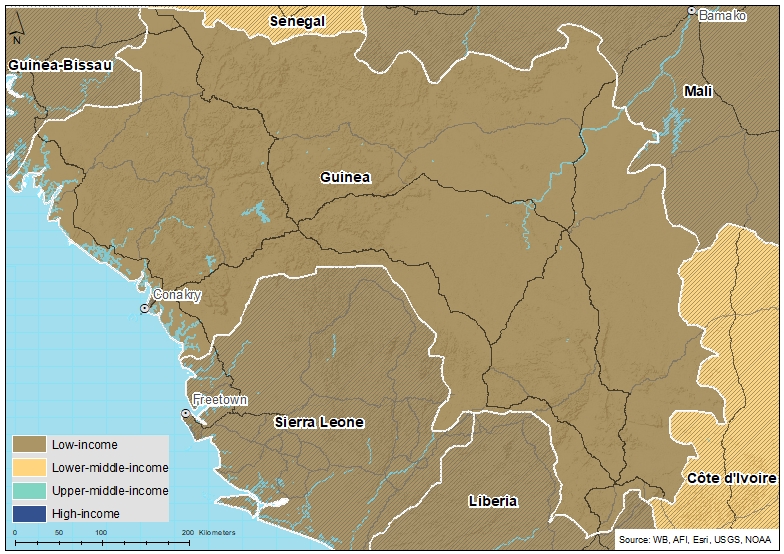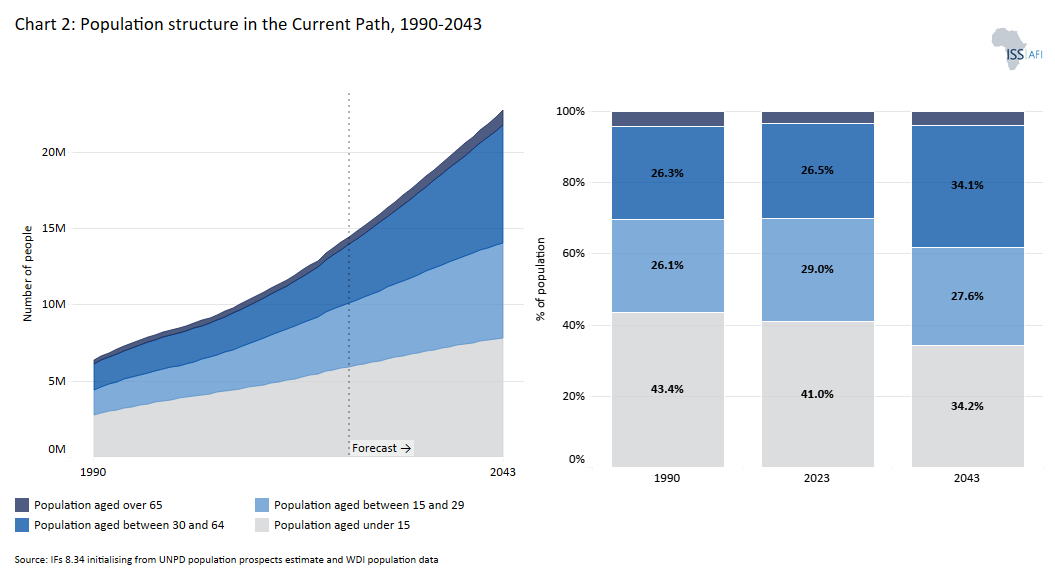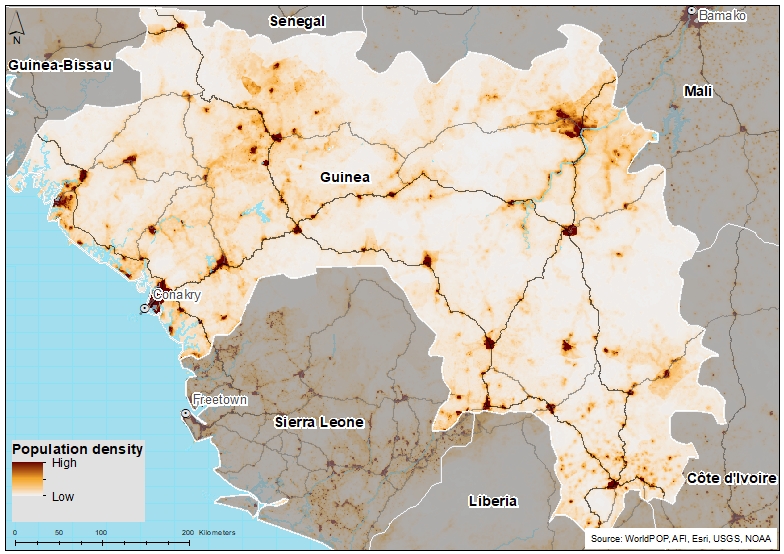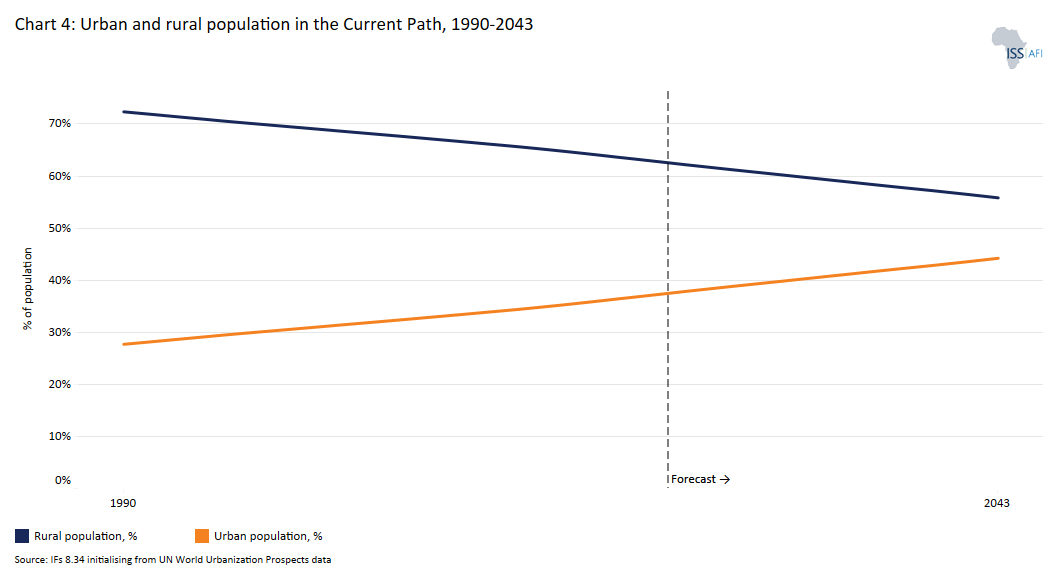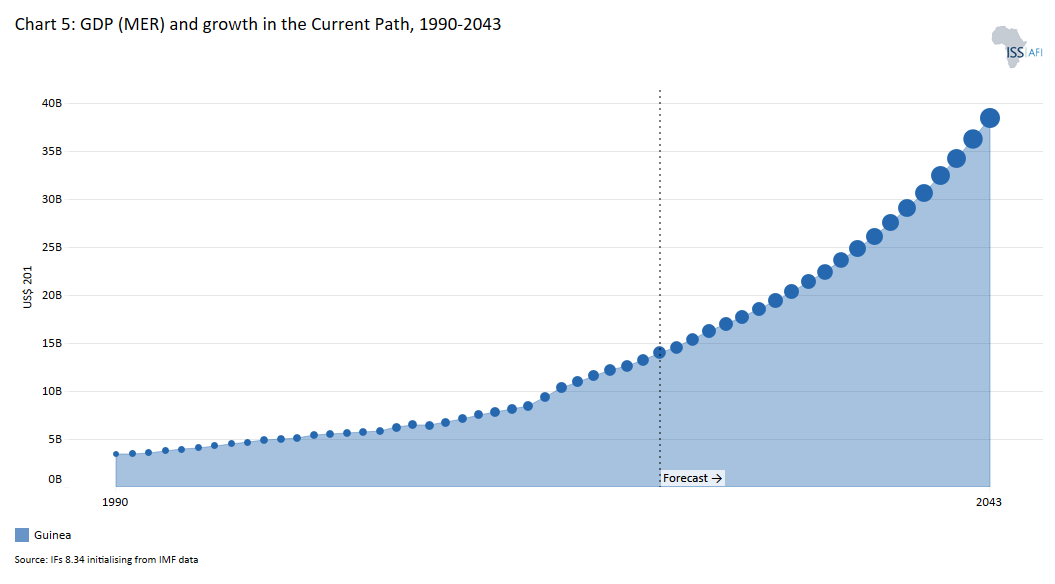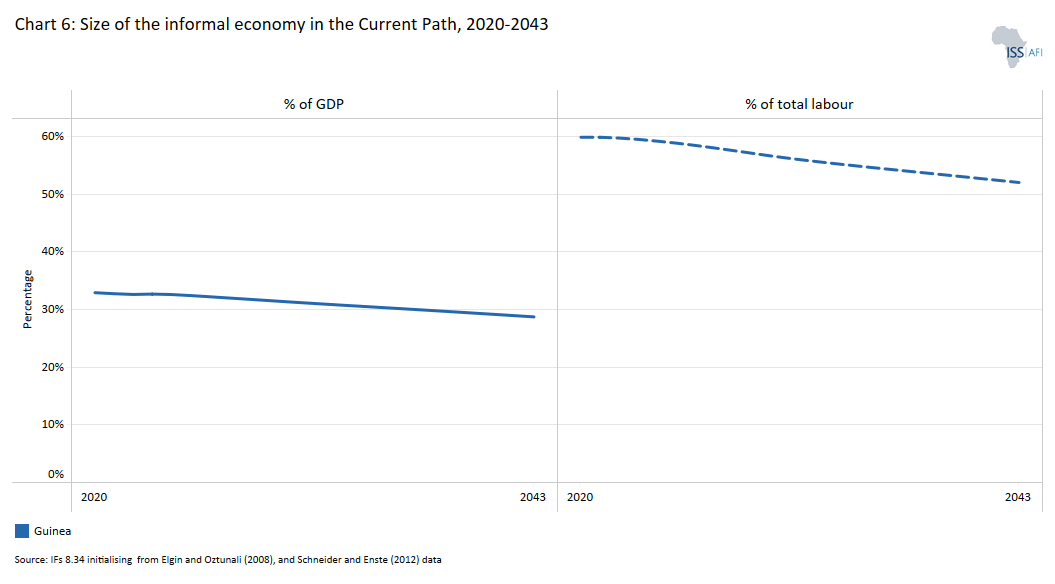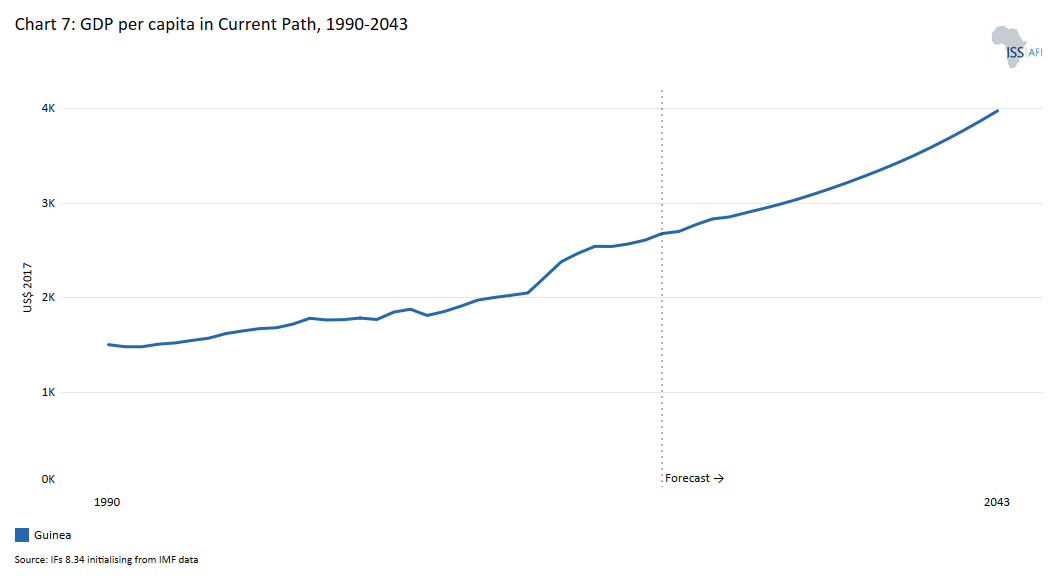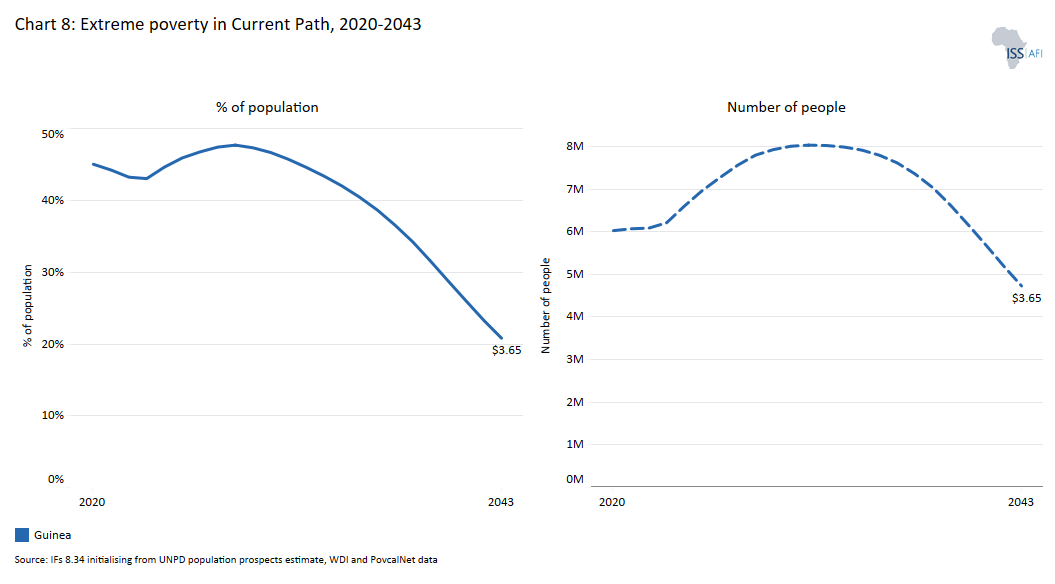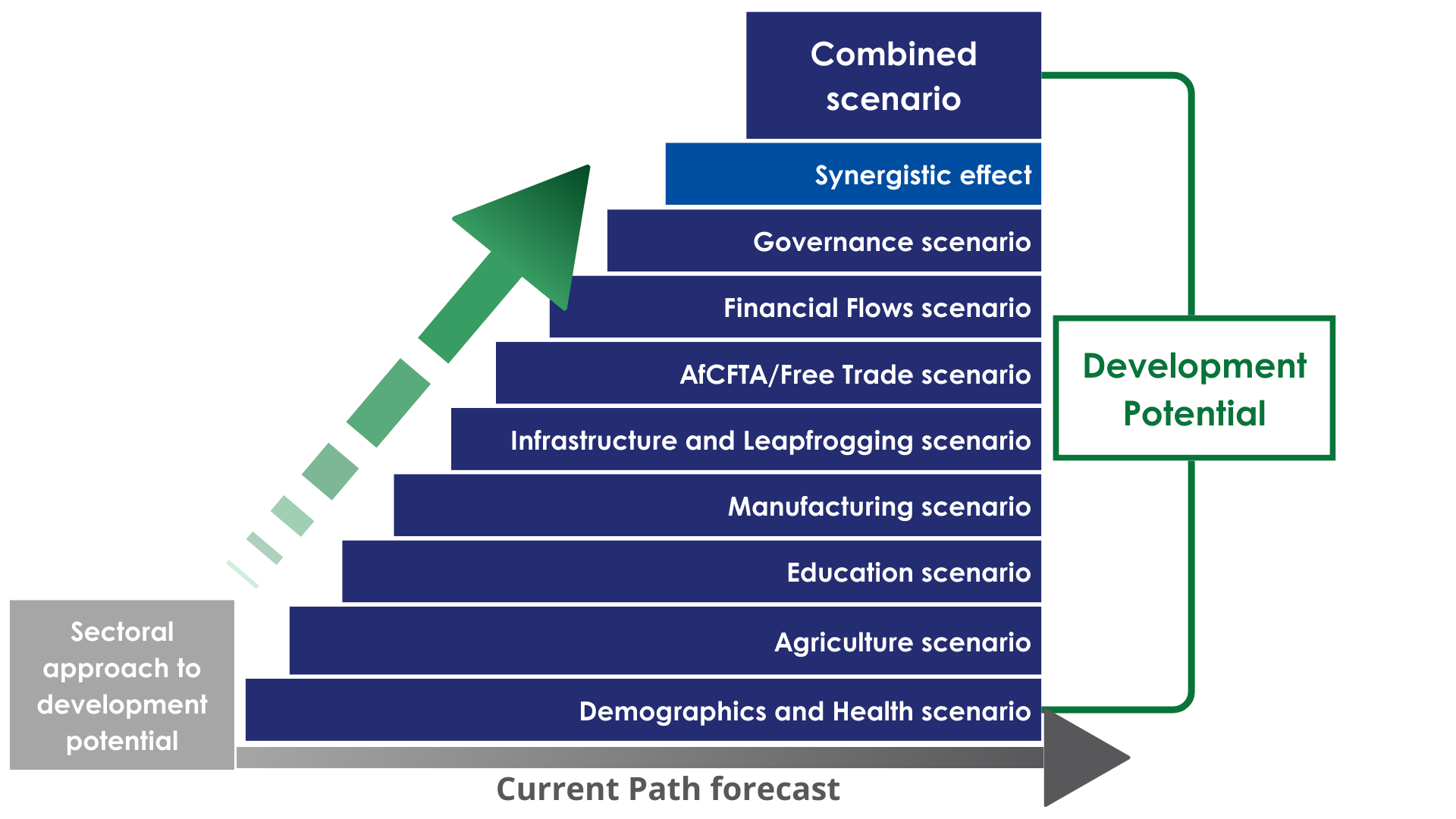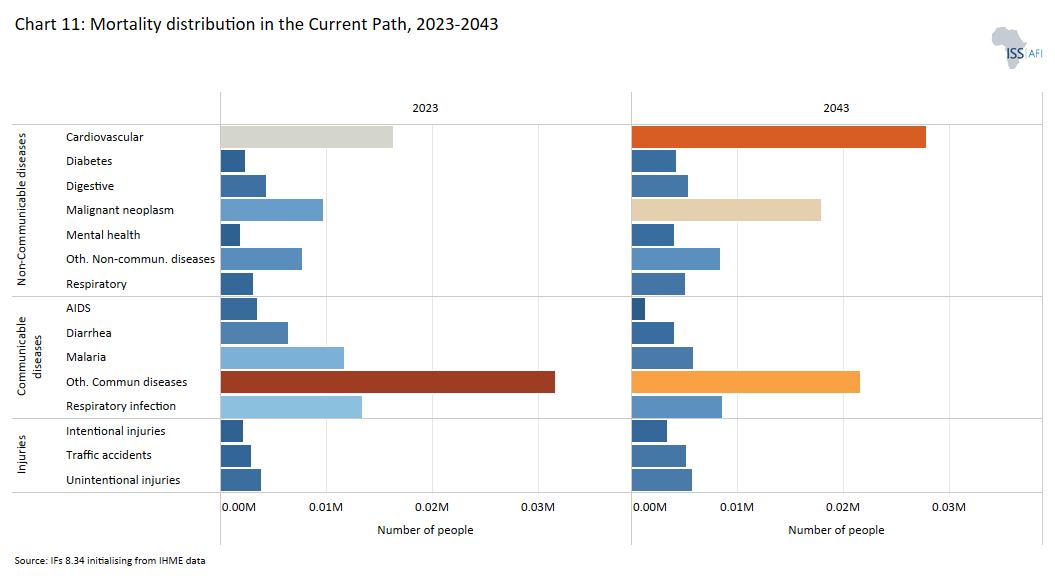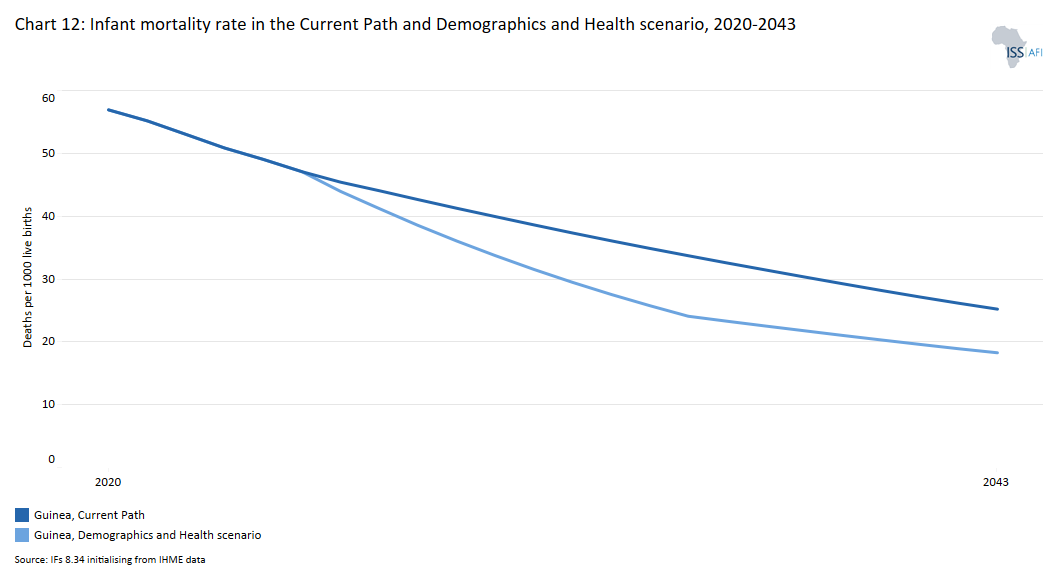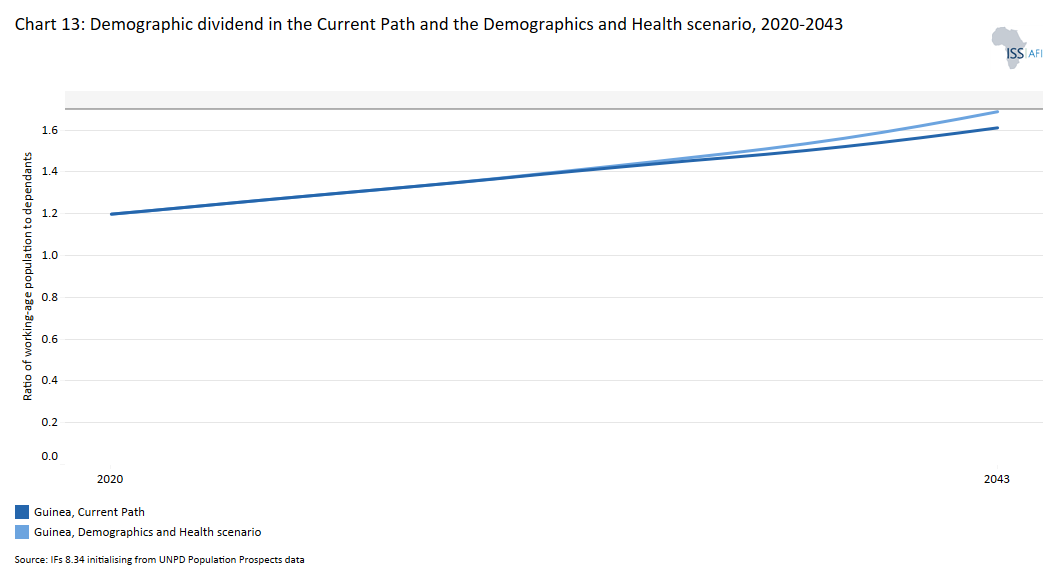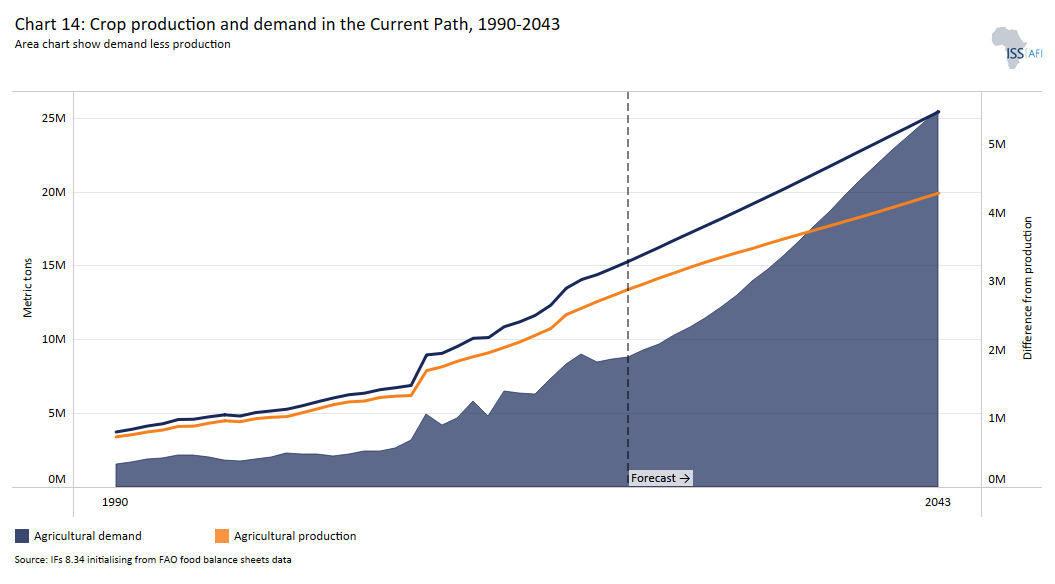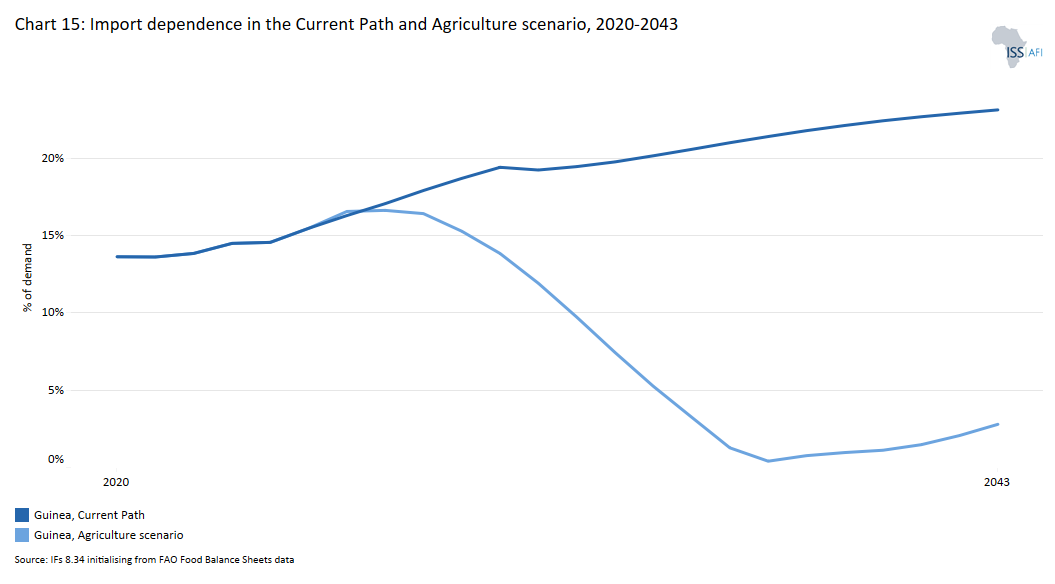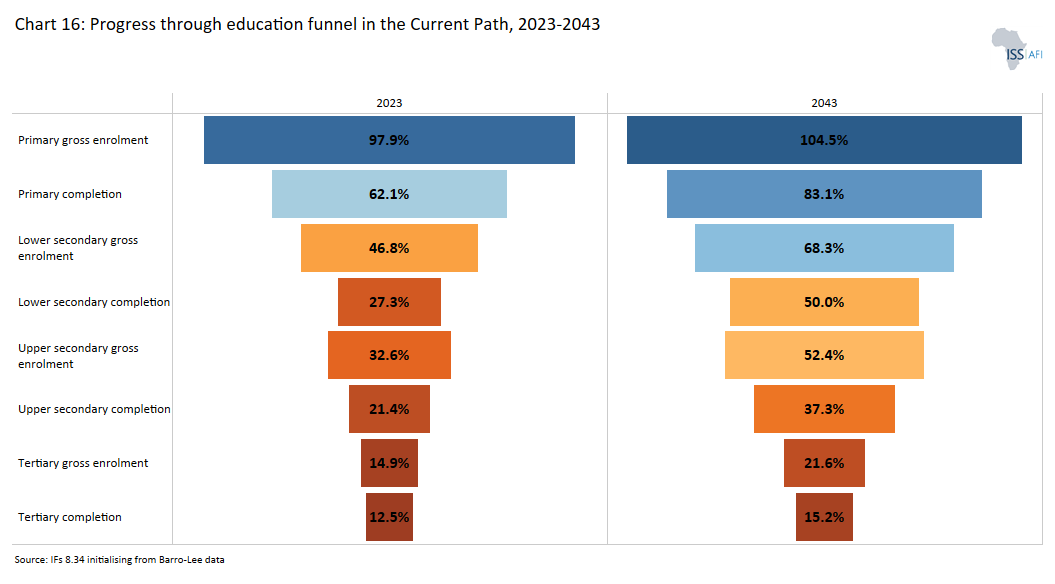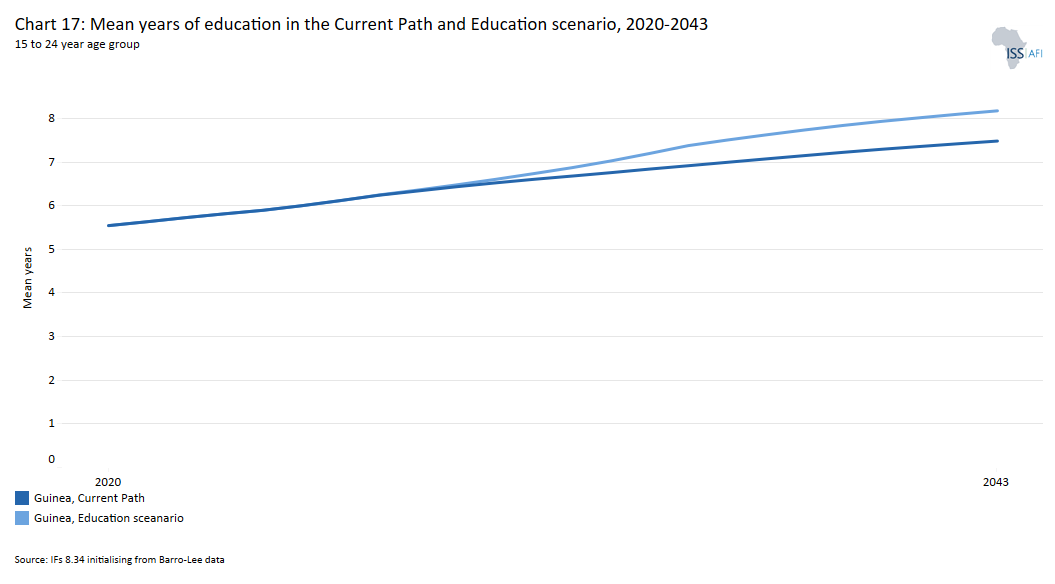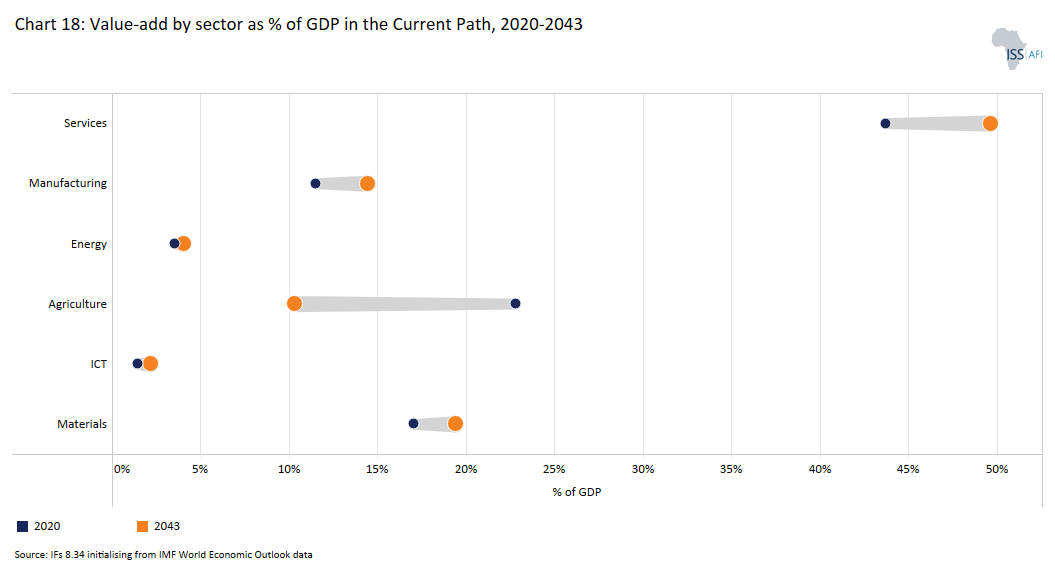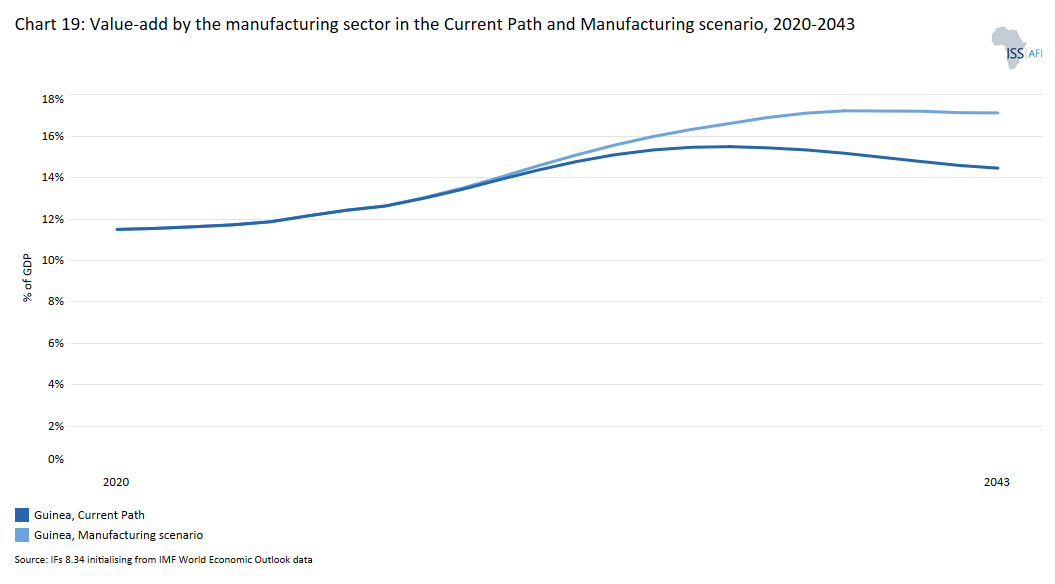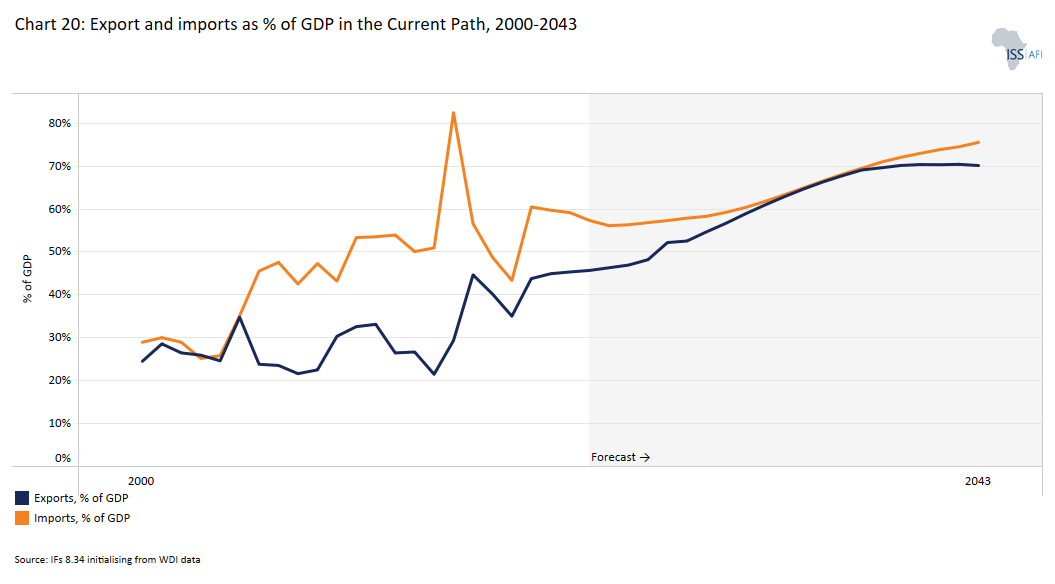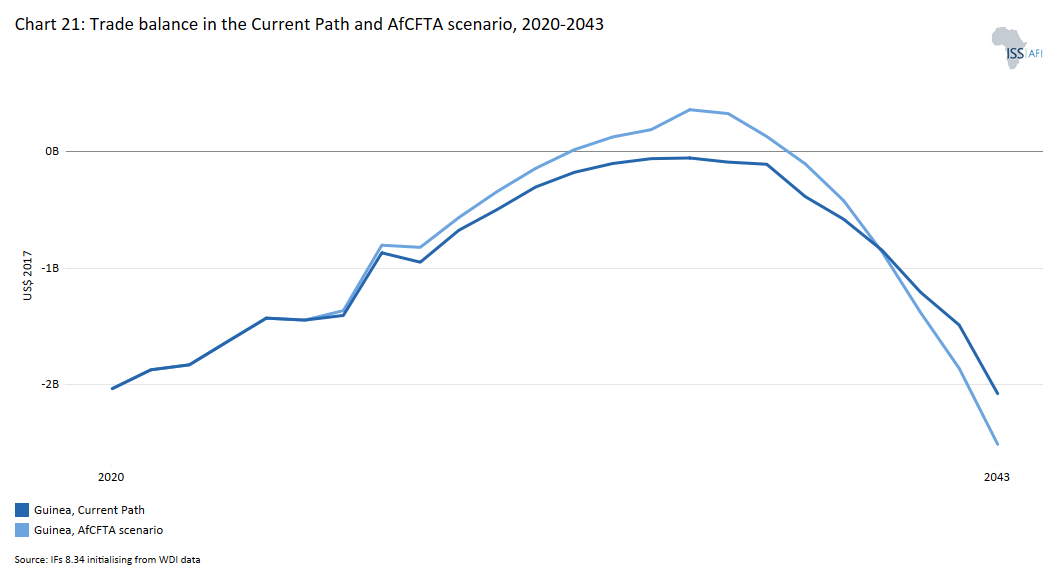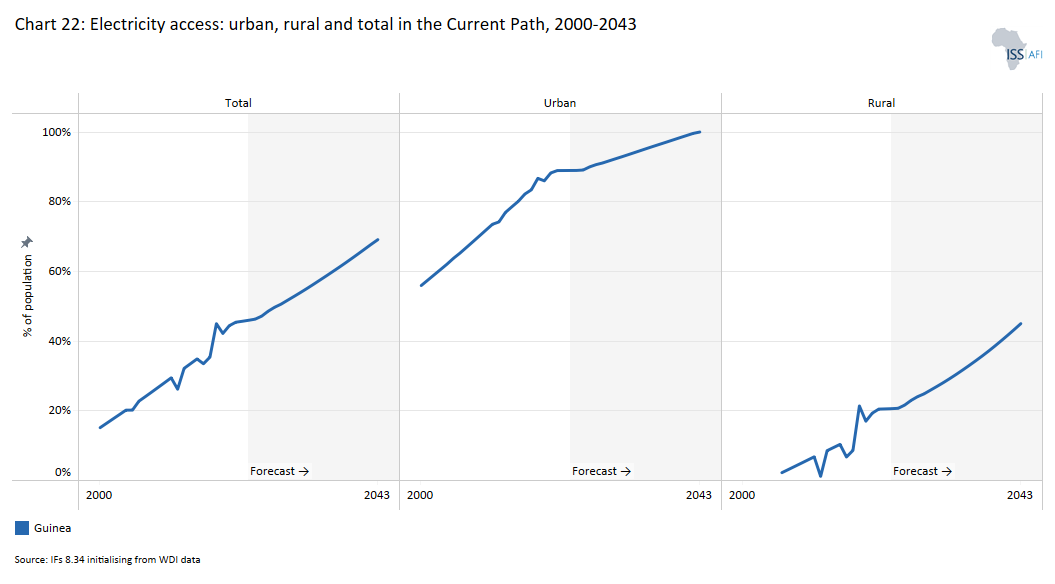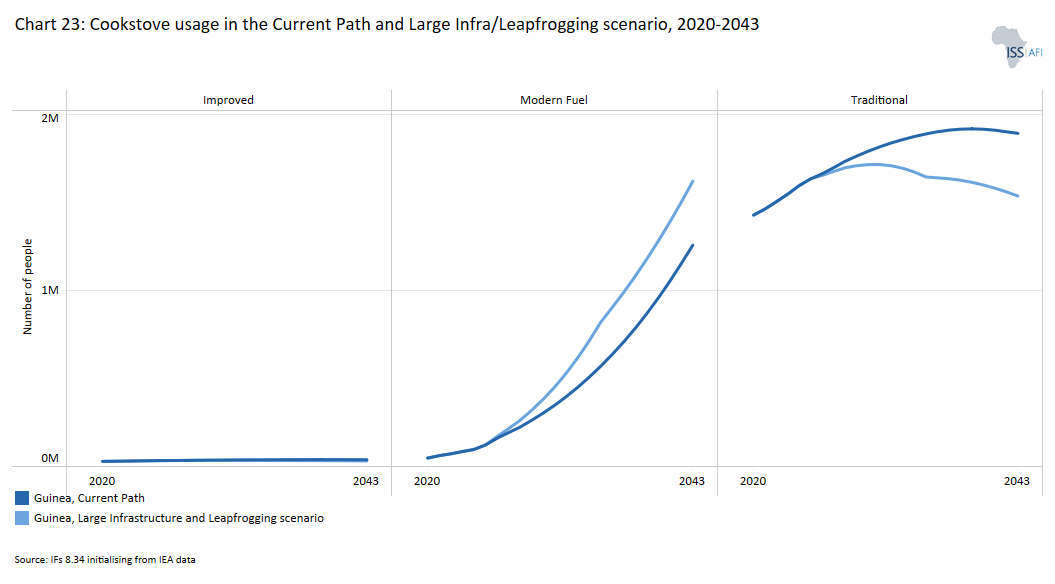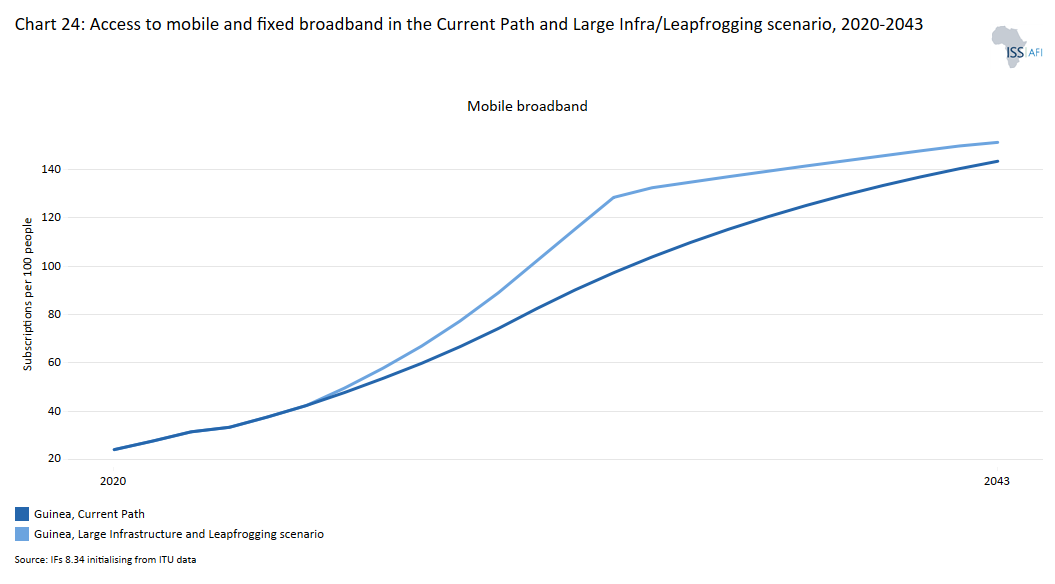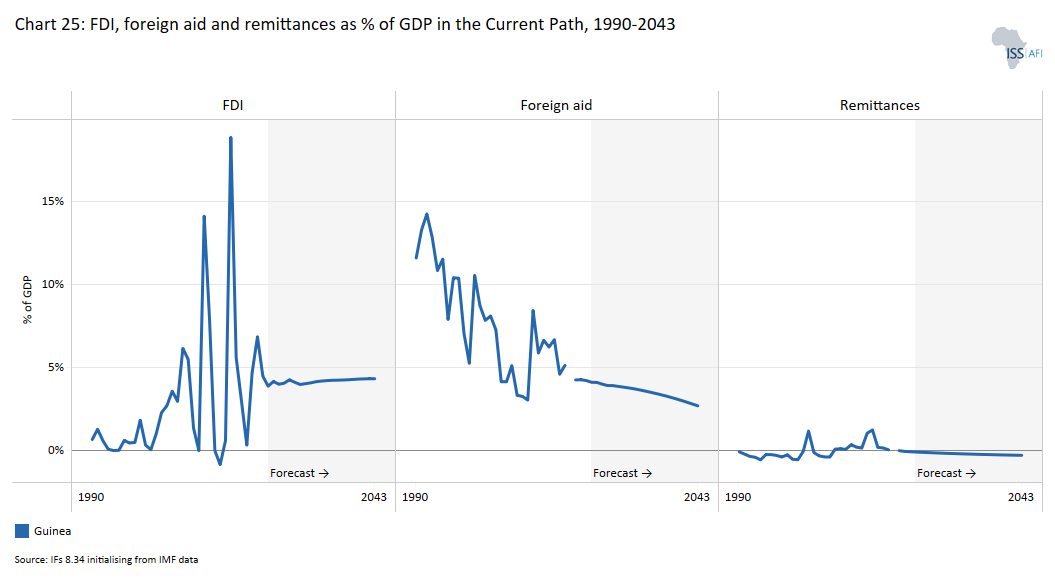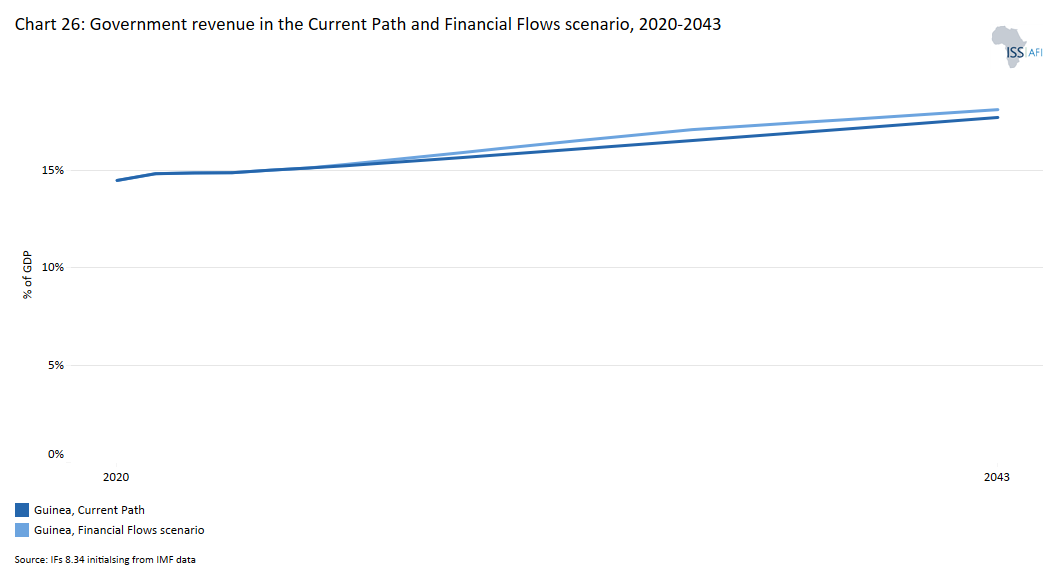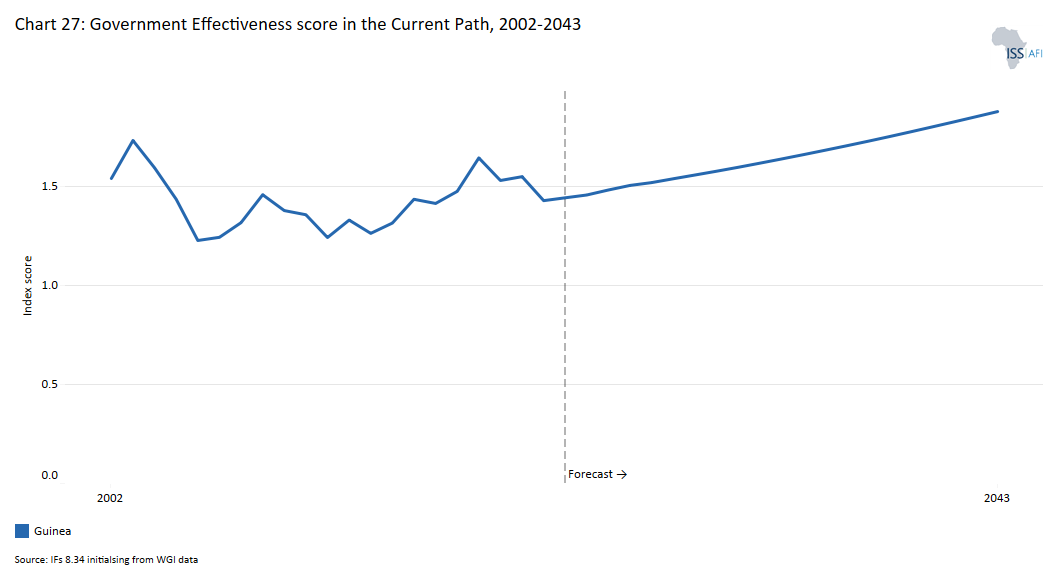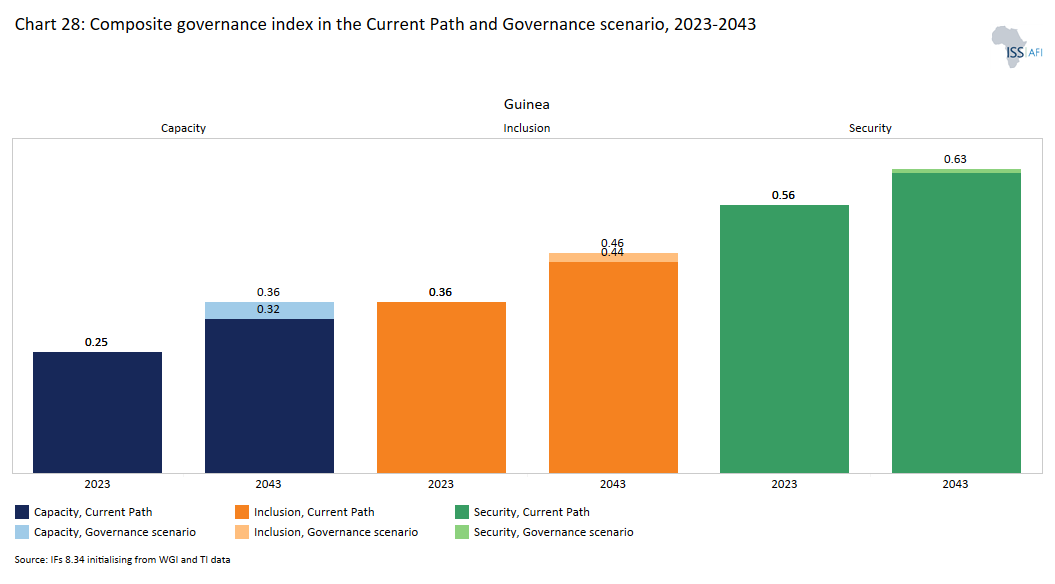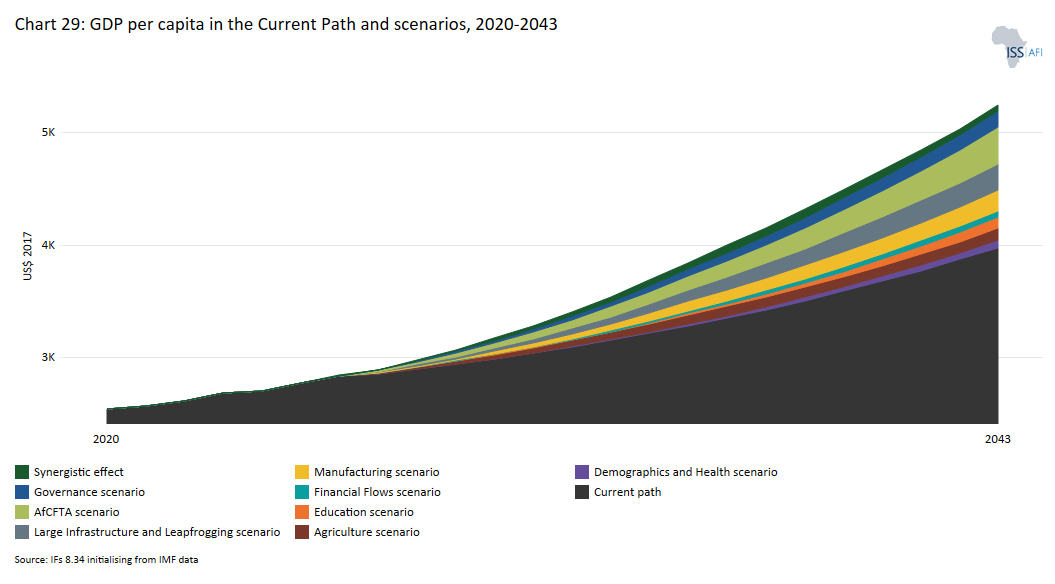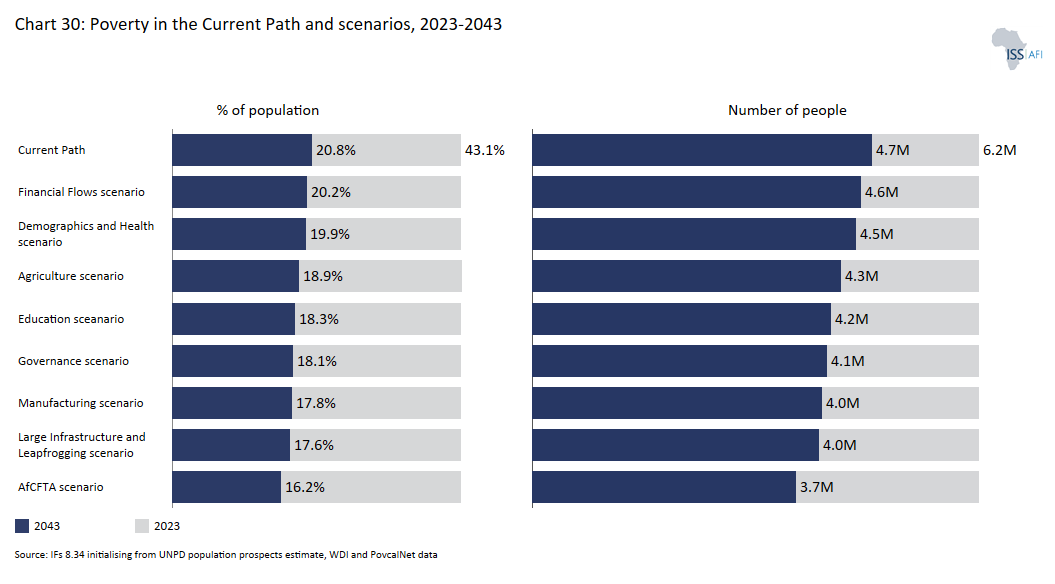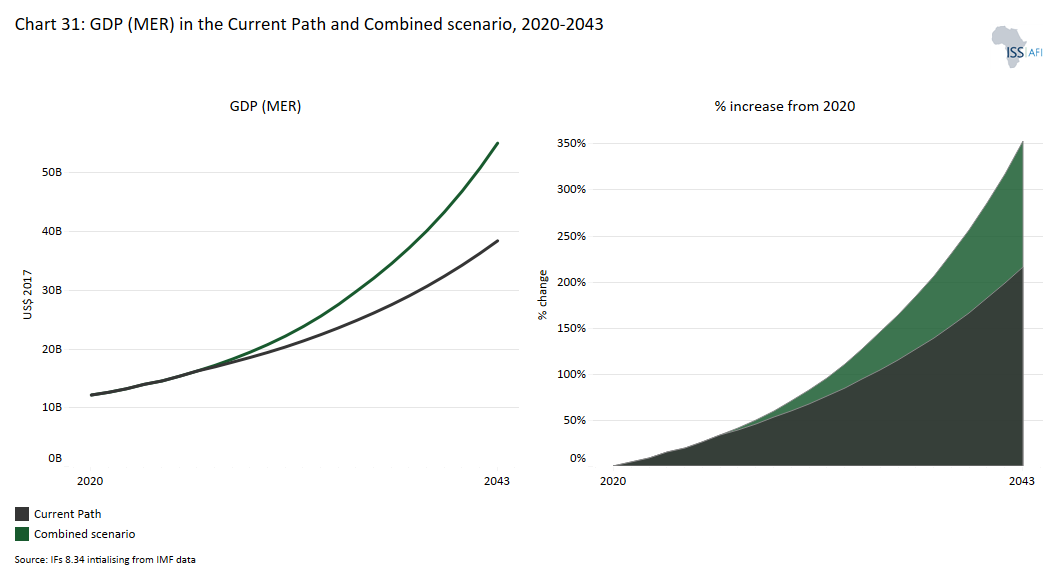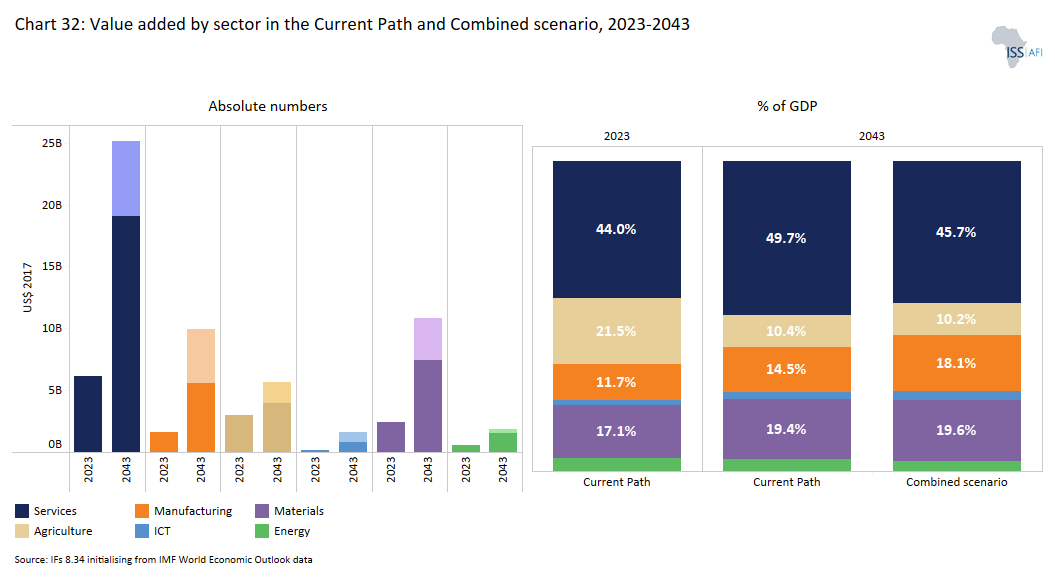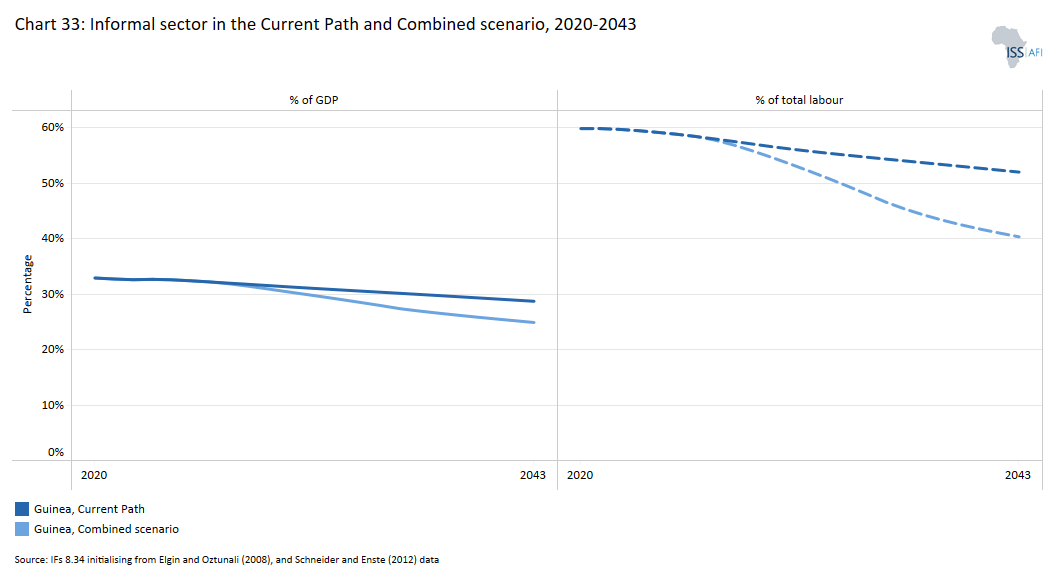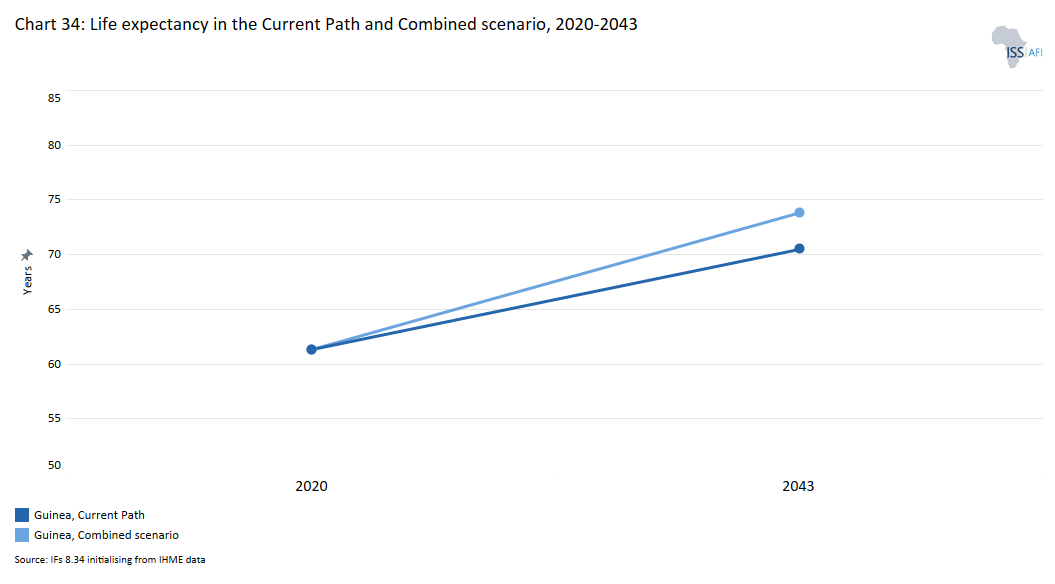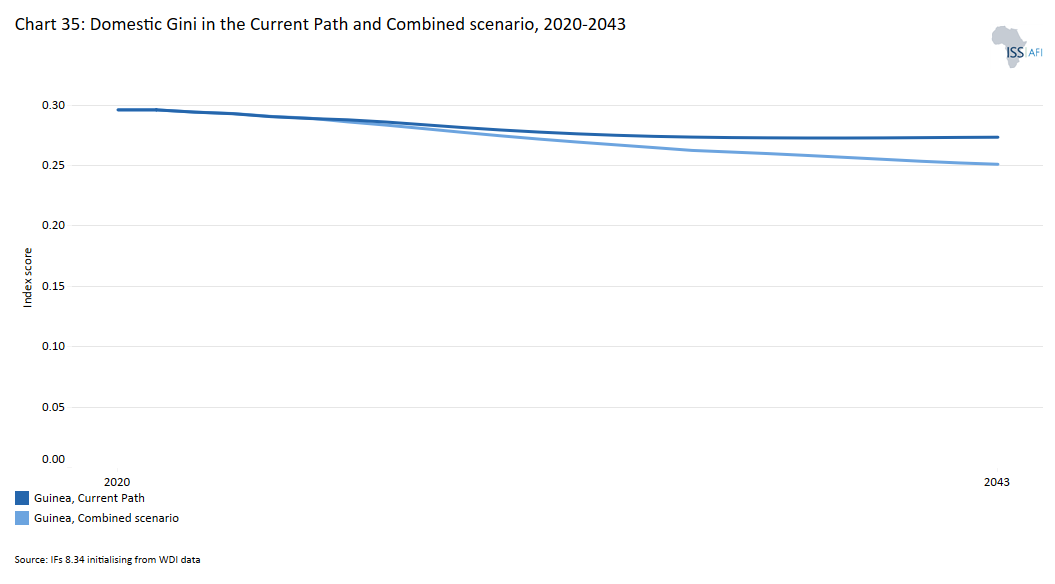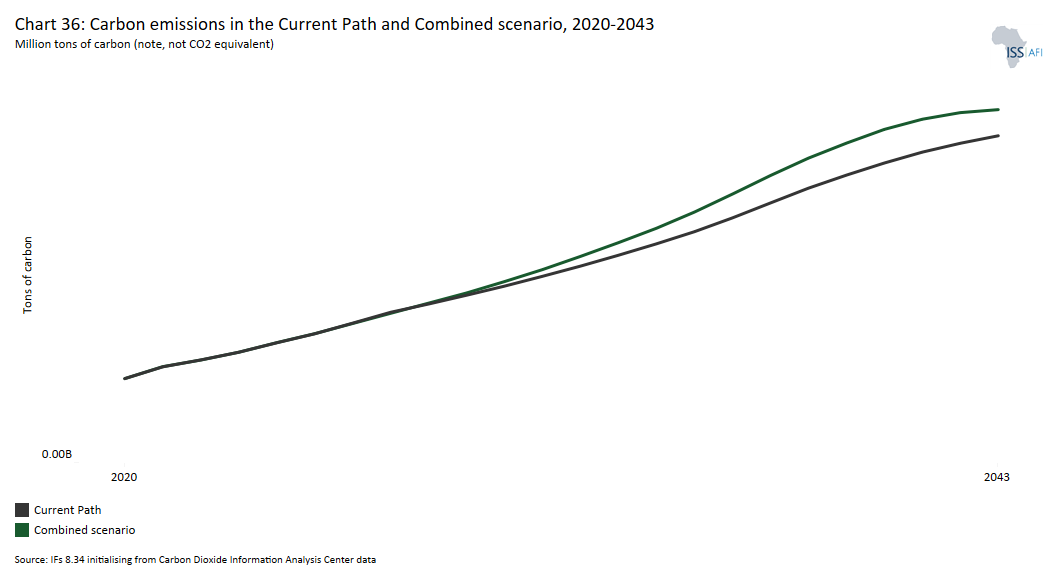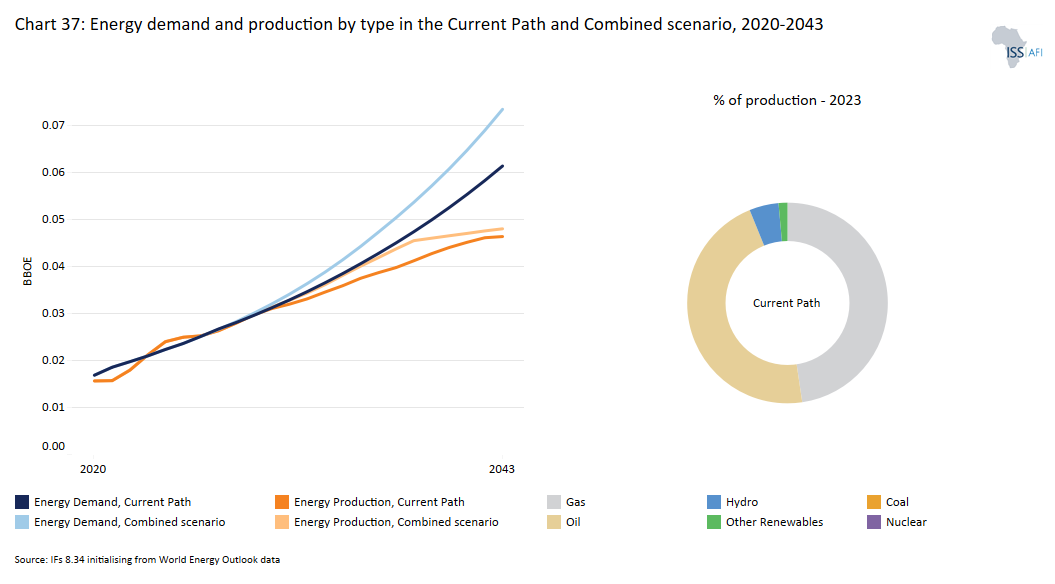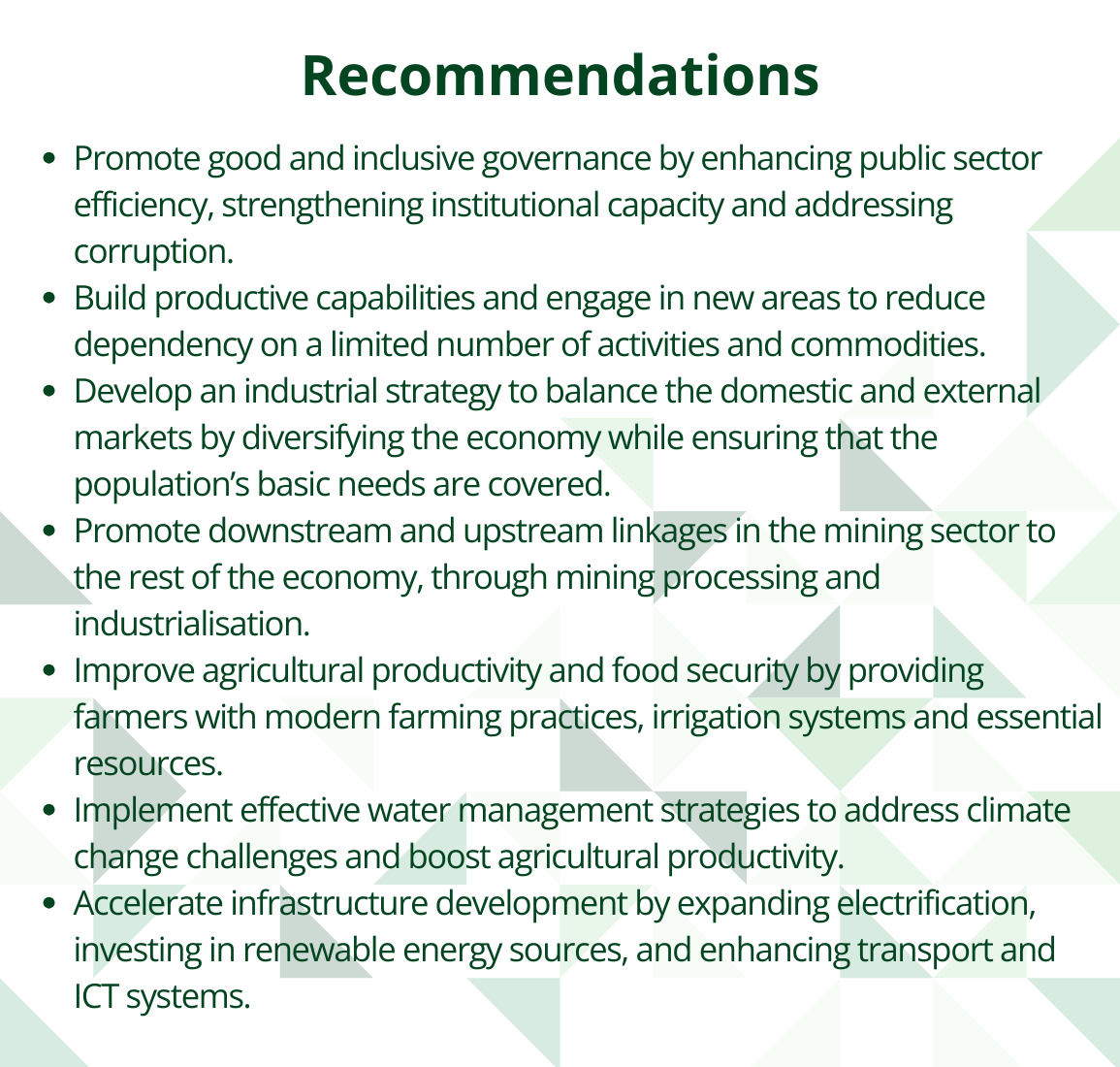 Guinea
Guinea
Feedback welcome
Our aim is to use the best data to inform our analysis. See our Technical page for information on the IFs forecasting platform. We appreciate your help and references for improvements via our feedback form.
This page explores Guinea's current and projected future development, examining various sectoral scenarios and their potential impacts on the country's growth. It explores eight individual sectoral scenarios that include education, governance, health and demographic, trade and infrastructure-related outcomes, and combines the impact of these eight scenarios for Guinea up to 2043 - the end of the third ten-year implementation plan for the African Union Agenda 2063. The analysis offers insights into policy actions that could enhance the country's developmental trajectory.
For more information about the International Futures modelling platform we use to develop the various scenarios, please see About this Site.
Summary
We begin this page with an introductory assessment of the country’s context by looking at current population distribution, social structure, climate and topography.
- Guinea is a lower-middle-income country bordered to the north by Guinea-Bissau, Senegal and Mali, and to the south by Sierra Leone, Liberia and Côte d’Ivoire. The country is rich in natural resources, energy potential and arable land. Agriculture, the largest employer in Guinea, is critical for poverty reduction and rural development, providing income for 57% of rural households and employing 52% of the total labour force. In addition to this sector, natural resources, processing industries and services are economic assets for Guinea. However, to fully harness these assets and accelerate structural transformation, the country needs to improve the quality of governance. It is ranked below the average for Africa’s lower-middle-income countries on most indices, also on progress in democratisation—with the most recent coup d’état occurring in 2021.
This section is followed by an analysis of the Current Path for Guinea which informs the country’s likely current development trajectory to 2043. It is based on current geopolitical trends and assumes that no major shocks would occur in a ‘business-as-usual’ future.
- Guinea's population has been increasing at a rapid annual rate of around 2.5% since 2008. By 2023, the population was estimated at 14.4 million, with 41.1% being under the age of 15. On the Current Path (business-as-usual scenario), the population will to grow to 17.2 million by 2030 and 22.7 million by 2043.
- Guinea's economy has faced significant challenges due to a history of political transitions and fluctuating commodity prices. It is largely driven by the mining and agriculture sectors. In 2023, the country's GDP stood at US$14 billion, with a growth rate of 5.7%. On the Current Path, Guinea's GDP growth will reach 4.6% in 2030 and 5.9% by 2043, with the GDP forecast to rise to US$19.4 billion in 2030 and US$28.4 billion by 2043.
- In 2023, Guinea advanced from lower-income to low-middle-income status due to increases in both Gross National Income (GNI) and GDP per capita. The country's GNI per capita grew from US$1 018 in 2021 to US$1 180 in 2022, while GDP per capita (at PPP constant 2017) rose from US$2 640 to US$2 700 during the same period. Despite rapid population growth, Guinea's GDP per capita has shown a consistent upward trend. On the Current Path, Guinea’s GDP per capita will increase to US$2 988 in 2030 and US$3 975 by 2043.
- Extreme poverty remains a significant challenge in Guinea. In 2023, about 11.9% of the population, equivalent to approximately 1.72 million people, lived on less than $2.15 per day. The rate will continue increasing until 2027, reaching 13.7%. Thereafter Guinea's poverty rate will gradually decrease, falling to 12.7% by 2030. By 2043, the poverty rate will have declined to approximately 2.9%.
- Guinea's national development strategy is guided by its long-term vision, Vision 2040 for a Prosperous and Emerging Guinea, which sets the strategic direction for the country's development through 2040.
The next section compares progress on the Current Path with eight sectoral scenarios . These are Demographics and Health; Agriculture; Education; Manufacturing; the African Continental Free Trade Area (AfCFTA); Large Infrastructure and Leapfrogging; Financial Flows; and Governance. Each scenario is benchmarked to present an ambitious but reasonable aspiration in that sector.
- The implementation of the Demographics and Health scenario will accelerate Guinea's demographic transition. In this scenario, the ratio of the working-age population to dependants will be at 1.7:1 by 2043, at which point the country will enter a potential demographic window of opportunity, provided other supporting conditions are in place. On the Current Path, this minimum ratio will only be achieved in 2047.
- In the Agriculture scenario, Guinea’s crop yields will increase to 4.5 metric tons per hectare by 2030, representing a 12% increase compared to the Current Path. By 2043, yields will reach 5.9 metric tons per hectare, reflecting a 27.4% increase relative to the Current Path for that year.
- The implementation of the Education scenario would increase the average years of schooling for adults aged 15 to 24 in Guinea to about 6.6 years by 2030 (6.9 years for males and 6.3 years for females). By 2043, this figure will rise to 8.2 years for both males and females, effectively closing the gender gap in education.
- The manufacturing sector represents a small portion of Guinea’s economy, primarily focused on agro-processing and light manufacturing. The implementation of the Manufacturing scenario will increase the share of the manufacturing sector as a percentage of GDP by 14% (to US$2.8 billion instead of US$2.7 billion) in 2030 and by 17.1% (to US$7 billion instead of US$5.6 billion) in 2043.
- Guinea's trade balance is structurally in deficit, a trend expected to continue throughout the forecast period. In the AfCFTA scenario, Guinea will record a trade deficit equivalent to 1.7% of GDP (US$0.3 billion) by 2030 and 5.8% (US$2.5 billion) in 2043.
- Like many African nations, Guinea faces significant infrastructure deficits. In the Large Infrastructure and Leapfrogging scenario, the proportion of households relying on traditional cookstoves will decrease from 93% in 2023 to 80.5% by 2030 and to 48.2% by 2043.
- Guinea is not a significant recipient of international capital flows. On the Current Path, FDI net inflows will increase to 4% by 2030 and further to 4.3% of GDP by 2043. In the Financial Flows scenario, FDI flows will increase to 5% of GDP in 2030 and reach 5.3% by 2043. Foreign aid will represent about 4% of GDP in 2030, decreasing to 3% by 2043.
- Guinea faces significant governance challenges, rooted in a history of military takeovers, transitional governments, authoritarian regimes, and contested elections. In the Governance scenario, Guinea’s governance score will improve to 0.41 in 2030, representing a 3.1% increase compared to the Current Path for that year. By 2043, the score will reach 0.48, reflecting a 4.5% improvement above the Current Path.
In the third section, we compare the impact of each of these eight sectoral scenarios with one another and subsequently with a Combined scenario (the integrated effect of all eight scenarios). In our forecasts, we measure progress on various dimensions such as economic size (in market exchange rates), gross domestic product per capita (in purchasing power parity), extreme poverty, carbon emissions, the changes in the structure of the economy, and selected sectoral dimensions such as progress with mean years of education, life expectancy, the Gini coefficient or reductions in mortality rates.
- Guinea's GDP per capita increases in all eight scenarios, with the AfCFTA scenario delivering the most significant gains in both the short (2030) and the long term (2043). In the short term, the Agriculture, Large Infrastructure and Leapfrogging, Manufacturing, and Governance scenarios follow the AfCFTA in terms of positive impact. By 2030, the Combined scenario will increase Guinea's GDP per capita by 4.7% above the Current Path, amounting to an additional US$139. In the long term, the AfCFTA scenario will be followed by the Large Infrastructure and Leapfrogging, Manufacturing, Governance, and Agriculture scenarios. By 2043, the Combined scenario will increase Guinea's GDP per capita by 29.4% compared to the Current Path, equivalent to US$321.
- All scenario interventions contribute to reducing extreme poverty at the US$2.15 threshold, except for the Financial Flows scenario, which will increase poverty in the short term due to FDI inflows that tend to initially increase inequality. These inflows are also primarily directed toward the mining sector, which has limited integration with the broader economy. The Agriculture scenario will have the most significant impact on reducing extreme poverty, followed by the Governance, AfCFTA, and Manufacturing scenarios. In the Combined scenario, extreme poverty will decrease to 11.3% by 2030, representing 241 142 fewer people in poverty compared to the Current Path. In the long term, the AfCFTA scenario will have the greatest impact on reducing extreme poverty by 2043, followed by the Education, Manufacturing, Large Infrastructure and Leapfrogging, and Governance scenarios. The Combined scenario will eradicate extreme poverty, reducing it to about 0.1% by 2043, equivalent to 572 589 fewer people living in poverty relative to the Current Path.
- The Combined scenario will increase Guinea’s carbon emissions by 3 million tons by 2030 and 5.9 million tons by 2043. By 2030, the AfCFTA, Agriculture, Manufacturing, and Governance scenarios will contribute the most to carbon emissions, respectively. By 2043, the primary contributors will shift to the AfCFTA, Manufacturing, Governance, and Agriculture scenario, respectively.
We end this page with a summarising conclusion, offering key recommendations for decision-making.
Guinea faces significant growth challenges, including insecurity, a lack of economic diversification, low agricultural productivity, a difficult business environment, inadequate infrastructure and limited human capital. Addressing these obstacles is crucial for achieving inclusive and sustainable growth. The government should focus on implementing comprehensive policy reforms and strategic investments to enhance good governance, infrastructure development, foster private sector development, boost agricultural productivity, strengthen the quality of human capital and diversify the economy beyond reliance on primary and commodity goods.
All charts for Guinea
- Chart 1: Political map of Guinea
- Chart 2: Population structure in the Current Path, 2020–2043
- Chart 3: Population distribution map, 2023
- Chart 4: Urban and rural population in the Current Path, 1990-2043
- Chart 5: GDP (MER) and growth rate in the Current Path, 1990–2043
- Chart 6: Size of the informal economy in the Current Path, 2020-2043
- Chart 7: GDP per capita in Current Path, 1990–2043
- Chart 8: Extreme poverty in the Current Path, 2020–2043
- Chart 9: National Development Plan of Guinea
- Chart 10: Relationship between Current Path and scenarios
- Chart 11: Mortality distribution in the Current Path, 2023 and 2043
- Chart 12: Infant mortality rate in Current Path and Demographics and Health scenario, 2020–2043
- Chart 13: Demographic dividend in the Current Path and the Demographics and Health scenario, 2020–2043
- Chart 14: Crop production and demand in the Current Path, 1990-2043
- Chart 15: Import dependence in the Current Path and Agriculture scenario, 2020–2043
- Chart 16: Progress through the education funnel in the Current Path, 2023 and 2043
- Chart 17: Mean years of education in the Current Path and Education scenario, 2020–2043
- Chart 18: Value-add by sector as % of GDP in the Current Path, 2023 and 2043
- Chart 19: Value-add by the manufacturing sector in the Current Path and Manufacturing scenario, 2020–2043
- Chart 20: Exports and imports as % of GDP in the Current Path, 2000-2043
- Chart 21: Trade balance in the Current Path and AfCFTA scenario, 2020–2043
- Chart 22: Electricity access: urban, rural and total in the Current Path, 2000-2043
- Chart 23: Cookstove usage in the Current Path and Large Infra/Leapfrogging scenario, 2020–2043
- Chart 24: Access to mobile and fixed broadband in the Current Path and the Large Infra/Leapfrogging scenario, 2020–2043
- Chart 25: FDI, foreign aid and remittances as % of GDP in the Current Path and in the Financial Flows scenario, 1990-2043
- Chart 26: Government revenue in the Current Path and Financial Flows scenario, 2020–2043
- Chart 27: Government effectiveness score in the Current Path, 2002-2043
- Chart 28: Composite governance index in the Current Path and Governance scenario, 2023 and 2043
- Chart 29: GDP per capita in the Current Path and scenarios, 2020–2043
- Chart 30: Poverty in the Current Path and scenarios, 2020–2043
- Chart 31: GDP (MER) in the Current Path and Combined scenario, 2020–2043
- Chart 32: Value added by sector in the Current Path and Combined scenario, 2023 and 2043
- Chart 33: Informal sector in the Current Path and Combined scenario, 2020–2043
- Chart 34: Life expectancy in the Current Path and Combined scenario, 2020–2043
- Chart 35: Domestic Gini in the Current Path and Combined scenario, 2023 and 2043
- Chart 36: Carbon emissions in the Current Path and Combined scenario, 2020–2043
- Chart 37: Energy demand and production by type in the Current Path and Combined scenario, 2020-2043
- Chart 38: Policy recommendations
Chart 1 is a political map of Guinea.
Previously low-income, in 2023, the World Bank classified Guinea as one of Africa’s 23 lower-middle-income countries. It is located in West Africa, and it is not to be confused with the other Guinea nations of Equatorial Guinea, Guinea-Bissau and Papua New Guinea. Guinea is bordered by six different countries, namely Guinea-Bissau, Senegal, Mali, Côte d'Ivoire, Sierra Leone and Liberia, as well as the Atlantic Ocean to the west. The country is divided into eight administrative regions, which are subdivided into 33 prefectures.
Guinea was the first former French colony in Africa to gain independence. It officially achieved independence in October 1958, following a referendum on the Constitution of the Fifth Republic in France held in September 1958, with Sékou Touré becoming its first president. The country became the 82nd member of the United Nations (UN) in December 1958 and one of the founding members of the Economic Community of West Africans States (ECOWAS) in June 1975.
President Touré was the president until his death in March 1984, when Louis Lansana Beavogui (Prime Minister at the time) became the interim president. President Beuvogui was succeeded by Colonel Lansana Conté, who formed the Military Committee for National Recovery (MCNR) in 1984. The MCNR banned political parties and dissolved the parliament. Nearly six years after the coup, a new constitution was approved in a referendum in December 1990.
In December 1993, Lansana Conté was elected as the third president of Guinea, in contested elections. Conté moved Guinea toward a market-based economy, opening the country to foreign investment, particularly in mining. However, his government is described as being plagued by widespread corruption, nepotism and a lack of infrastructure development.
Conté was the president of Guinea until his death in December 2008, when Captain Moussa Dadis Camara assumed leadership and announced the suspension of the constitution. The leadership change in 2008 prompted international responses, including from the AU and EU. The AU subsequently imposed diplomatic sanctions (suspension of membership) and the EU suspended economic assistance. In 2009, the AU further imposed travel restrictions and an assets freeze, targetting the military junta. The Economic Community of West African States (ECOWAS) also suspended Guinea’s membership, while the United States (US) government imposed economic sanctions against the military junta.
In November 2010, Alpha Condé was elected president of Guinea with 53% of the vote in the second round of presidential elections, subsequent to which the AU and ECOWAS lifted diplomatic and economic sanctions.
In 2021, Guinea underwent a leadership transition under the National Committee of Reconciliation and Development (CNRD), leading to its suspension from ECOWAS and the AU.
The coup was preceded by a series of demonstrations against constitutional amendments that enabled Condé to contest the elections for a third term and subsequently win amidst allegations of fraud. Colonel Mamady Doumbouya was sworn in as the President of the Transition in October 2021.
The transition to civilian governance, initially targeted for December 2024, is ongoing, with discussions on the implementation timeline continuing.
Guinea is known for its diverse landscape, including coastal plains, mountains and savannas. Its geography is divided into four regions: Maritime Guinea on the low-lying Atlantic coast, the Fouta Djallon or Middle Guinea highlands, the Upper Guinea savanna region in the northeast, and the Guinée forestière region of tropical forests. The climate is tropical, with a dry harmattan season in the winter and a rainy season in the summer.
Conakry is Guinea's capital and its largest city, with a population of over two million people. Nzérékoré, located in the Guinée forestière region in Southern Guinea, is the second-largest city.
Guinea's total population was 14.4 million people in 2023. Approximately 84% of the country’s population are Muslim, 11% are Christian, and 5% follow indigenous religions or other belief systems.
Endowed with abundant natural resources, Guinea has the potential to be an economic leader in the extractives sector. The country has the largest reserves of bauxite (aluminium ore) and the largest untapped deposits of highgrade of iron ore in the world. Guinea also has diamonds, gold, uranium, alumina and some oil deposits. The Simandou iron ore mine is located in the Simandou mountain range of southern Guinea's Nzérékoré Region. It is known for its high-grade iron ore deposits and has been the subject of numerous mining disputes given its potential of becoming a significant source of iron ore globally.
The country’s hilly and mountain landscape provides excellent conditions for hydroelectric dam construction. Guinea also experiences heavy rainfall, particularly in its tropical and forested regions, which ensures water supply to its rivers and dams for most of the year. Hydroelectric power offers a clean and renewable energy source, which aligns with global efforts to reduce carbon emissions and combat climate change.
Chart 2 presents the Current Path of the population structure, from 2020 to 2043.
Guinea is home to three major ethnolinguistic groups: the Fulani (Peul), who make up approximately 41% of the population; the Mandinka (Malinké), accounting for around 33%; and the Soussou (Susu), comprising about 12%. French serves as Guinea's official language. Alongside French, several Indigenous languages, including Fula, Malinké and Susu, are widely spoken and recognised.
The country’s population has been growing rapidly at about 2.5% per year since 2008. In 2023, the country’s population was 14.4 million, and on the Current Path, it will reach 17.2 million by 2030 and 22.7 million by 2043—the end of the third 10-year implementation plan for the AU agenda 2063.
The country’s fertility rate has declined from an average of 6.5 births per woman in the 1980s to 4.2 births per woman in 2023, still about 8.7% above the average for lower-middle-income African countries. On the Current Path, Guinea’s fertility rate declines to 3.9 births per woman by 2030 and to about 3.1 by 2043.
Infant and maternal mortality rates in Guinea have also declined significantly, reflecting improvement in education and healthcare. Infant mortality has declined from 65.2 deaths per 1 000 live births in 2014 to 50.9 in 2023. On the Current Path, infant mortality will decline to 30 by 2030 and further to 25.2 by 2043. The rate will remain above average for lower-middle-income African countries until 2034.
Maternal mortality has declined from 661 deaths per 100 000 live births in 2005 to 502 in 2023. In the Current Path, rates will reach 412 deaths per 100 000 by 2030 and 236.8 by 2043. The rate will remain above average for lower-middle-income African countries until 2027.
Guinea’s life expectancy has consistently improved since its independence due to efforts in public health and social services. However, it remains below Africa’s average due to challenges such as poverty, limited healthcare access, and a high prevalence of communicable diseases. Between 2000 and 2005, the average life expectancy for males and females was 55 years. By 2023, it has increased to 63 years. On the Current Path, Guinea’s life expectancy will increase to 66 years (64.3 years for men and 67.8 for women) by 2030 and 70.5 years by 2043.
The country’s population structure is characterised by a youthful demographic—with an estimated median age of 19.1 years in 2023. The rapidly growing and youthful population presents both opportunities and challenges. Currently, the country is faced with challenges related to poverty, healthcare and education. On the Current Path, the median age will increase to 20.3 by 2030 and to 23.2 by 2043.
As of 2023, about 41.1% of the country’s population was under 15 years of age. With this youthful population structure, Guinea’s dependency ratio is high, as a large portion of the population depends on a small workforce to provide for its needs—which contributes to rising poverty levels. However, the share of the population under 15 years of age will decrease slightly to 38.6% by 2030 and to 34.2% by 2043 as the total population size increases.
When the ratio of the working-age population (15-64 years of age) to dependants (children and elderly) is 1.7 to one or higher, countries often experience more rapid growth, known as the demographic dividend, provided the workforce is appropriately skilled and absorbed in the labour market. In 2023, Guinea’s ratio of working-age population to dependants was at 1.2 working-age persons to every dependant. On the Current Path, Guinea is likely to only enter a potential demographic window of opportunity as from 2047.
Guinea has a large youth bulge at 49.2% in 2023 – defined as the ratio of the population between 15 and 29 years to the total adult population (15+ years of age). In addition to the requirement for more spending on education, health services and job creation, having a large number of young adults can lead to positive political change in a country through youth activism. However, they can also carry the seeds for socio-political instability in the absence of economic opportunities. On the Current Path, Guinea’s youth bulge will decline to 46.6% by 2030 and to 41.9% by 2043.
Similar to many other African countries, Guinea's persistently high fertility rate is attributed to various factors, including socio-cultural, knowledge-related (awareness of family planning options), and healthcare service-related influences. Although recent efforts have been made to expand family planning services, demand remains high among adolescents and young women in Guinea.
Chart 3 presents a population distribution map for 2023.
Guinea's population density is shaped by geographic, economic and demographic factors. In 2023, the country had an average population density of nearly 0.59 people per hectare. The total land area is 245 857 km² (2 458 700 hectares). Population density is unevenly distributed, with higher concentrations in and around capital areas such as Conakry and Kindia. Notably, there is a significant presence of residents from Sierra Leone in these two cities due to the geographic proximity.
Labé and Mamou serve as the administrative centers of their respective regions and are characterised by high population densities. In the Boké region, near the Guinea-Bissau border, the port city of Kamsar is the most densely populated area, driven by its role in the bauxite supply chain, which attracts numerous workers. In contrast, Nzérékoré, located in the south near the Côte d'Ivoire border, is among the most sparsely populated regions.
Chart 4 presents the urban and rural population in the Current Path, from 1990 to 2043.
The pace of rural-to-urban migration has been slow in Guinea. Between 2019 and 2023, Guinea's urban population grew by about 1% annually which is 0.3 percentage points below the average for lower-middle-income African countries over the same period. The slow rate of urbanisation presents significant opportunities for economic development and renewal.
With proper planning, urbanisation can play a pivotal role in driving economic growth and development by accelerating the provision of a range of services (e.g., education and health), fostering entrepreneurship and boosting productivity. However, challenges such as energy shortages, infrastructure deficits, limited skills, inefficient business regulations, and restricted access to finance hinder the productivity potential of Guinea's urban areas. Addressing these issues should be a priority for the current government, specifically in Conakry and Kindia.
In the 1990s, about 70% of the Guinean total population lived in rural areas that declined to 62.5% in 2023. On the Current Path, the rate of urbanisation in Guinea will increase to about 39.8% by 2030 and 44.2% by 2043.
Chart 5 presents GDP in market exchange rates (MER) and growth rate in the Current Path, from 1990 to 2043.
Guinea's history of political transitions, fluctuating commodity prices, and the aftermath of the Ebola epidemic have had a significant impact on economic growth. The economy is primarily based on the mining and agriculture sectors. Since 1985, the country has made efforts to implement policies that liberalise the economy to allow private sector participation. The IMF and the World Bank were actively involved in various economic reform packages that contributed to notable economic growth, with an average growth rate of around 4% between 1985 and 2000. However, in 2002, the IMF suspended Guinea's Poverty Reduction and Growth Facility (PRGF) due to the government’s inability to meet the targets. This compelled the country to fund its policies through reliance on the central bank, a strategy that ultimately proved expensive.
In 2004 Guinea was re-admitted into the PRGF, growing at 3% in 2005 compared to 1.2% in 2003. Its GDP increased by nearly US$3 million during the same period. By 2008, Guinea’s GDP had grown by nearly 19% compared to its level in 2003.
In 2023, Guinea's GDP was US$14 billion, with a growth rate of 5.7%, driven largely by the mining sector, with gold and aluminium ore extraction playing a pivotal role. While the GDP growth rate is encouraging, economic challenges persist. The mining sector's weak linkages to the domestic economy have limited its impact on job creation and poverty reduction.
Looking ahead, on the Current Path, Guinea’s GDP growth will be 4.6% in 2030 and 5.9% by 2043, reaching a projected GDP of US$19.4 billion in 2030 and US$28.4 billion by 2043.
Chart 6 presents the size of the informal economy as per cent of GDP and per cent of total labour (non-agriculture), from 2020 to 2043. The data in our modelling are largely estimates and therefore may differ from other sources.
The informal economy comprises activities that have market value and would add to tax revenue and GDP, if they were recorded. Countries with high informality face multiple development challenges, including low revenue mobilisation, higher poverty, lower per capita incomes, greater inequality, and weaker productivity investment. Therefore, high levels of informality tend to constrain economic growth but often serves as a survival sector in countries facing high levels of poverty.
With over 60% of Guineans residing in rural areas and relying on subsistence agriculture for their livelihoods, the informal economy plays a crucial role in Guinea's economic landscape, significantly contributing to both GDP and employment.
The informal economy has helped Guinea reduce extreme poverty; in 2023, an estimated 59.5% (equivalent to 5.2 million people) of the total labour force (non-agriculture) was informally employed, and women constituted 42.1% of the total labour force in the informal economy.
Guinea's informal sector has experienced a gradual decline in its share of GDP over time. In 2023, the informal economy accounted for approximately 32.7% of Guinea's GDP, down from about 45% in the early 1980s. Despite this reduction, the size of Guinea's informal economy is above the 2023 averages of 30.6% for lower-middle-income countries in Africa and 26.2% for the continent as a whole.
On the Current Path, the informal sector's share of GDP in Guinea will decrease to 31.4% by 2030 and further to 28.7% by 2043, driven by anticipated development improvements reflected in rising GDP per capita. However, these levels will still exceed the forecast averages of 29.5% in 2030 and 27.1% in 2043 for lower-middle-income African countries.
Chart 7 presents GDP per capita in the Current Path, from 1990 to 2043, compared with the average for the Africa income group.
In 2023, Guinea transitioned from a low-income to a lower-middle-income status as both Gross National Income (GNI) and GDP per capita had increased. Guinea's GNI per capita rose from US$1 018 in 2021 to US$1 180 in 2022, while its GDP per capita (at PPP) increased from US$2 640 to US$2 700 over the same period. This reclassification by the World Bank reflects the country's economic growth, driven notably by the mining sector, which has played a significant role in its improved income level.
Guinea's GDP per capita has steadily risen over time, even amid rapid population growth. This consistent upward trend in recent years highlights the country's strong GDP growth outpacing its population increase.
With an expected increase in GDP growth coupled with slower population growth, Guinea's Current Path shows a GDP per capita of US$2 988 in 2030 and US$3 975 by 2043—more than 45% below the projected averages for lower-middle-income African countries.
Chart 8 presents the rate and numbers of extremely poor people in the Current Path from 2020 to 2043.
In 2022, the World Bank updated the poverty lines to 2017 constant dollar values as follows:
- The previous US$1.90 extreme poverty line is now set at US$2.15, also for use with low-income countries.
- US$3.20 for lower-middle-income countries, now US$3.65 in 2017 values.
- US$5.50 for upper-middle-income countries, now US$6.85 in 2017 values.
- US$22.70 for high-income countries. The Bank has not yet announced the new poverty line in 2017 US$ prices for high-income countries.
Despite robust economic growth in recent years, extreme poverty is a major challenge in Guinea. Weak mining sector linkages to the rest of the economy, including through employment, has prevented this growth from translating into significant poverty reduction and shared prosperity. The global economic disruptions resulting from the COVID-19 pandemic and the conflict in Ukraine have further hindered efforts to reduce poverty. The country's high fertility rates are also seen to contribute to poverty.
In 2023, approximately 11.9% of the population, or around 1.72 million people, lived on less than US$2.15 per day, a decrease from 13.4% in 2019. The poverty rate is far more prevalent in rural than in urban areas. The majority of the rural population depends on subsistence agriculture and has limited access to basic infrastructure, education and healthcare, resulting in a disproportionately higher share of people living below the international poverty line of US$2.15 per day. Given that the majority of Guineans live in rural areas, this underscores significant regional disparities. And it emphasises the importance of focusing economic and social policy measures on rural areas to achieve a more significant impact on improving the population's well-being.
In 2024, extreme poverty was estimated at 12.5% and will continue increasing until 2027, reaching 13.7%. After 2027, Guinea's poverty rate will gradually decline, reaching 12.7% by 2030. Thus, on the Current Path, Guinea is unlikely to achieve the Sustainable Development Goal (SDG) target of reducing extreme poverty below 3% (at US$2.15 per day) by 2030. By 2043, Guinea is expected to achieve a poverty rate of approximately 2.9%, representing about 6 600 individuals—a significant milestone, even as the population growth rate gradually increases.
As a lower-middle-income country, Guinea applies a poverty benchmark of US$3.65 per day. Based on this standard, Guinea's poverty rate stood at 43.1% in 2023. On the Current Path, this rate will rise to 46.7% by 2030 before declining significantly to 20.8% by 2043.
However, monetary poverty provides only a partial view of the situation. The global Multidimensional Poverty Index (MPI) offers a broader perspective by assessing acute poverty through overlapping deprivations across 10 indicators, divided into three equally weighted dimensions: health, education and standard of living. The MPI complements the international US$2.15 a day poverty rate by identifying who is multidimensionally poor and also shows the composition of multidimensional poverty. The headcount or incidence of multidimensional poverty is often several percentage points higher than that of monetary poverty. This implies that individuals living above the monetary poverty line may still suffer deprivations in health, education and/or standard of living.
In the 2024 Global MPI report, 66.2% of the population in Guinea was multidimensionally poor in 2018 (an increase from 61.9% in 2016), compared to the international monetary poverty of 14.5% at US$2.15 per day in 2018 (a decrease from 18.4% in 2016).
Chart 9 depicts the National Development Plan of Guinea.
Guinea's development plan is closely aligned with national and international frameworks, such as the UN SDGs and the AU's Agenda 2063. This alignment fosters coherence and synergy in advancing the country's development initiatives.
Guinea’s long-term development strategy, “Vision 2040: For a Prosperous and Emerging Guinea,” sets out the country’s strategic priorities for sustainable development over the next two decades. It highlights key strategic directions and fosters a dialogue process that incorporates input from all sectors of society to envision potential future pathways. Guinea’s Vision 2040 aims to achieve a diversified and competitive economy. To bring this vision to life, Guinea has developed successive medium-term strategies, such as the National Economic and Social Development Plan (PNDES) 2016–2020 and the PNDES 2021–2025, which focus on building strong institutional foundations for economic, social and environmental progress while prioritising human capital development.
The eight sectoral scenarios as well as their relationship to the Current Path and the Combined scenario are explained in the About Page. Chart 10 summarises the approach.
Chart 11 presents the mortality distribution in the Current Path for 2023 and 2043.
The Demographics and Health scenario envisions ambitious improvements in child and maternal mortality rates, enhanced access to family planning, and decreased mortality from communicable diseases (e.g., AIDS, diarrhoea, malaria, respiratory infections) and non-communicable diseases (e.g., diabetes), alongside advancements in safe water access and sanitation. This scenario assumes a swift demographic transition supported by heightened investments in health and water, sanitation, and hygiene (WaSH) infrastructure.
Visit the themes on Demographics and Health/WaSH for more detail on the scenario structure and interventions.
There is a close relationship between population size and health. A country's health status affects fertility, mortality and morbidity rates, while rapid population growth increases the demand for essential resources, including nutrition and healthcare.
Guinea faces significant health and demographic challenges shaped by its population dynamics, healthcare infrastructure and socioeconomic conditions. The Government of Guinea’s Ministry of Health, through its National Health Development Plan (PNDS) 2015-2024, characterised the country’s health system as weak. It highlights several critical challenges, including persistently high levels of morbidity and mortality, particularly among vulnerable groups such as mothers and new-borns; limited coverage of essential health services with questionable quality; inefficient and inequitable delivery of care; and significant obstacles in areas such as adequate equipment and infrastructure. The situation was further exacerbated by the 2014-2016 Ebola outbreak, leaving the health system still in recovery from its devastating effects.
Guinea has one of the highest mortality rates in Africa. Mortality distribution is influenced by a combination of communicable diseases (CDs) and non-communicable diseases (NCDs). CDs include malaria, lower respiratory infections, diarrhoea and HIV/AIDS. NCDs include cardiovascular, diabetes, digestive, malignant neoplasm and mental health.
In 2023, cardiovascular and lower respiratory infections were major contributors to mortalities in Guinea. Cardiovascular conditions remain the leading cause of death among the elderly. The lack of adequate healthcare access, particularly in rural areas, worsens the effects of these illnesses. Inadequate sanitation, unsafe drinking water and limited access to proper hygiene are major factors contributing to deaths from diarrheal diseases, particularly among children.
As of 2023, 32.1% of Guineans still lacked access to safely managed water, while only 13.7% of the population had access to safely managed sanitation. On the Current Path, by 2030, only 34.9% of the population will have access to safely managed water, and 18.9% to safely managed sanitation—falling significantly short of the SDG universal target of 98%.
However, recent initiatives, including the USAID June 2023 Project Notre Sante, indicate a positive trajectory toward improvement. The stunting rate among children under the age of five has declined from 32.4% in 2016 to 29.2% in 2023, 2.6 percentage points above the average for lower-middle-income African countries. On the Current Path, Guinea's stunting rate is projected to reach 24.7 percent by 2030 (on track to meet the SDG target) and further reduce to 17.5 percent by 2043.
Maternal mortality has declined significantly, from 626 deaths per 100 000 live births in 2016 to 502.2 in 2023. However, this rate remains higher than the average for both lower-middle-income African countries and the continent as a whole. The reduction in maternal mortality can be attributed to various factors, including improvements in healthcare systems, policies and community engagement. On the Current Path, Guinea's maternal mortality rate will decline further, reaching 420 deaths per 100 000 live births by 2030—significantly above the SDG target of fewer than 70 deaths per 100 000 live births—and 236.8 deaths per 100 000 live births by 2043.
With a declining trend in deaths from CDs and a rising trend in deaths from NCDs, Guinea is expected to experience its epidemiological transition by 2032, when NCDs-related death rates will surpass those from CDs. This transformation is driven by demographic shifts, urbanisation, changing lifestyles, and improved access to healthcare. The growing burden of NCDs poses significant challenges for Guinea's healthcare system given the higher costs associated with treating NCDs, requiring substantial investments to build the capacity needed to address this evolving health landscape.
Chart 12 presents the infant mortality rate in the Current Path and in the Demographics and Health scenario, from 2020 to 2043.
The infant mortality rate is the probability of a child born in a specific year losing their life before reaching the age of one. It measures the child-born survival rate and reflects the social, economic and environmental conditions in which children live, including their health care. It is measured as the number of infant deaths per 1 000 live births and is an important marker of the overall quality of the health system in a country.
Infant mortality in Guinea has decreased from approximately 63.3 deaths per 1 000 live births in 2016 to about 50.9 deaths in 2023. On the Current Path, it will decline further to around 40 deaths per 1 000 live births by 2030, falling short of the SDG target of 25 deaths per 1 000 live births. Guinea is forecast to meet this target only by 2043 on the Current Path.
The interventions in the Demographics and Health scenario mean that infant mortality rate decrease to 33.8 deaths per 1 000 live births in 2030 and further decline to 18.3 deaths per 1 000 live births in 2043, implying much more rapid progress although still significantly below that required to achieve the SDG target.
Chart 13 presents the demographic dividend in the Current Path and in the Demographics and Health scenario, from 2020 to 2043.
The demographic dividend is the window of economic growth opportunity that opens when the ratio of working-age persons to dependants increases to 1.7 to 1 and higher.
The demographic dividend, which refers to potential economic growth resulting from changes in a country's population structure, is influenced by factors such as declining fertility rates and improvements in health and education. With fewer dependants to support, families and governments can allocate more resources to savings, education, infrastructure and economic development, driving accelerated growth.
In 2023, Guinea’s ratio was estimated at about 1.2 people of working age for each dependant. On the Current Path, the ratio increases to about 1.4 by 2030 and further increases to 1.6 by 2043. Guinea will enter its first demographic window of opportunity by 2047, when the ratio will reach 1.7:1.
The implementation of the Demographics and Health scenario will accelerate the demographic transition in Guinea. In the scenario, the ratio of the working-age population to dependants will reach the 1.7 threshold by 2043. However, attaining the demographic dividend does not automatically translate to economic growth; the Guinea government must ensure that the growing labour force is adequately skilled and effectively integrated into the economy.
Chart 14 presents crop production and demand in the Current Path from 1990 to 2043.
The Agriculture scenario envisions an agricultural revolution that ensures food security through ambitious yet feasible increases in yields per hectare, thanks to improved management, seed, fertiliser technology, and expanded irrigation and equipped land. Efforts to reduce food loss and waste are emphasised, with increased calorie consumption as an indicator of self-sufficiency and prioritising it over food exports. Additionally, enhanced forest protection signifies a commitment to sustainable land use practices.
Visit the theme on Agriculture for our conceptualisation and details on the scenario structure and interventions.
The agriculture sector in Guinea plays a crucial role in the country's economy and livelihoods. It is a cornerstone of food security, poverty reduction, employment and economic development, particularly for rural populations. Guinea’s agriculture sector is the country’s largest employer, provides employment for 52% of the labour force, income for 57% of rural households and accounted for 27.3% of the country’s GDP in 2022.
Guinea's major crops include cassava, cocoa, coffee, cotton, maize, millet, sorghum, palm oil and various fruits and vegetables, such as bananas, pineapples, mangoes and potatoes. The country has considerable potential for growth in the agricultural sector. Soil, water and climatic conditions provide opportunities for large-scale irrigated farming and agro-processing.
However, the country's agricultural production largely depends on rain-fed farming, with most farmers relying on seasonal rainfall due to limited irrigation infrastructure. This reliance on rain-fed agriculture makes the sector highly vulnerable to climate change, including droughts and irregular rainfall, which can significantly impact yields and food security.
Enhancing irrigation systems and implementing effective water management strategies are essential to addressing these challenges and boosting agricultural productivity.
Guinea has an estimated 15.5 million hectares of arable land, of which 3.85 million hectares (25%) are farmed, and 10% are cultivated annually. In 2023, 20 300 hectares of land were under irrigation. On the Current Path, this area will decrease slightly to 20 000 hectares by 2030 before modestly rising to 20 200 hectares by 2043. The decline in irrigated land in Guinea is primarily due to inadequate maintenance and the lack of modernisation, which reduce the functionality and efficiency of irrigation infrastructure.
Guinea's national budget allocated to agriculture is limited. In 2024, the Guinean government doubled its allocated funding for the agriculture sector to US$30 million. Despite this increase, the allocation remains relatively low compared to the sector's significance in the economy and given the total government budget for 2024, which was around US$15.4 billion – it represented about 0.2% of the total budget. This allocation falls short of the AU's Comprehensive Africa Agriculture Development Programme (CAADP) recommendation, which advises member countries to allocate at least 10% of their national budgets to agriculture and rural development and to achieve agricultural growth rates of at least 6% per annum. However, the government has committed to allocating 12.5% of its budget to agriculture, compared with the current percentage.
In 2023, Guinea's agricultural yield was estimated at 3.6 tons per hectare, placing it 22nd among 54 African nations. These yields represented a 29.4% improvement from 2.8 tons per hectare in 2016 but remains relatively low. By 2030, crop yields will increase to about 4 tons per hectare and further to around 4.7 tons per hectare by 2043 on the Current Path.
In 2023, Guinea produced an estimated 13.4 million metric tons of crops, falling short of the estimated crop demand of 15.3 million metric tons, resulting in a deficit of 1.9 million metric tons. However, this represents a substantial increase in production compared to the 9.8 million metric tons produced in 2016.
On the Current Path, Guinea’s crop production will increase to 15.9 million metric tons in 2030, while the demand will be 18.7 million metric tons - resulting in a deficit of 2.8 million metric tons. By 2043, the deficit is anticipated to widen further to 5.5 million metric tons, with demand reaching 25.4 million metric tons and production at 19.9 million metric tons. This growing shortfall will heighten the country's reliance on imports, with import dependency increasing from 14.6% of demand in 2023 to 19.4% by 2030 and further to 22.8% by 2043.
Chart 15 presents the import dependence in the Current Path and the Agriculture scenario, from 2020 to 2043.
The Agriculture scenario will benefit Guinea by increasing yields, reducing vulnerable rain-fed crops through irrigation schemes, reducing post-harvest losses and tapping into the country’s agricultural potential.
In the Agriculture scenario, average crop yields will rise to 4.5 metric tons per hectare by 2030, representing a 12% increase compared to the Current Path. By 2043, yields would reach 5.9 metric tons per hectare, reflecting a 27.4% increase relative to the Current Path for that year.
The Agriculture scenario significantly reduces crop import dependency, lowering it to approximately 13.6% of demand by 2030, compared to 19.4% in the Current Path. By 2043, import dependency will decline to just 1.4% of demand, representing a 93.9% reduction compared to the Current Path for that year.
Chart 16 depicts the progress through the educational system in the Current Path, for 2023 and 2043.
The Education scenario represents reasonable but ambitious improvements in intake, transition, and graduation rates from primary to tertiary levels and better quality of education at primary and secondary levels. It also models substantive progress towards gender parity at all levels, additional vocational training at the secondary school level, and increases in the share of science and engineering graduates.
Visit the theme on Education for our conceptualisation and details on the scenario structure and interventions.
The age structure of a population, particularly one with a high proportion of youth, calls for significant investments in education to promote economic growth and social development. Greater investment in quality education is crucial for reducing poverty and managing population growth, especially when every child has a chance to benefit from it.
Guinea, like many other African countries, is experiencing a learning crisis. According to estimates from the World Bank, UNESCO and other organisations, 83% of children face learning poverty (inferior education quality), meaning they are unable to read and comprehend an age-appropriate text by age 10. This issue is partly due to the significant number of out-of-school children who miss the opportunity to develop reading proficiency. Learning poverty is one of the factors contributing to low educational attainment. Addressing this crisis requires a strong focus on improving the quality of education delivered in schools.
Inadequate school infrastructure remains a significant concern in Guinea. Despite the Guinean government's pledge to align its education budget with international standards by increasing it to 4-6% of GDP (or 15-20% of public expenditure), the allocation has been steadily declining from 2.4% of GDP in 2020 to slightly less than 2% in 2022 - getting close to an all-time low.
Poorly equipped classrooms, libraries and sanitation facilities significantly impact the quality of education and discourage children from attending school. Many schools, particularly in rural areas, struggle with a shortage of essential learning materials, including textbooks, reference resources and teaching aids, which undermines the effectiveness of both teaching and learning. The country’s primary education system has a pupil-teacher ratio of approximately 80:1, indicating that there were about 80 students per teacher, significantly higher than the global average of 24:1 in the same year. The SDG goal 4 emphasises improving teacher recruitment, training and working conditions to address pupil-teacher imbalances and enhance educational quality.
Prior to independence, Guinea's education system was modelled on that of France. All schools were nationalised in 1961. The current education structure is similar to other countries in the region, with schooling comprising four levels (pre-primary school, primary school, secondary school, and tertiary level).
French remained the primary language of instruction from primary to tertiary level. While indigenous languages are widely spoken in daily life, French serves as the medium for teaching, government administration and formal communication.
Pre-primary education in Guinea, designed to prepare children aged 3 to 4 years for primary school, is generally fee-based and highly concentrated in urban areas. This limits access for many families, particularly those in rural regions or from low-income households.
Primary school education is free and compulsory for all children between the ages of 7 and 13, but net enrolment was only 80.9% (86.6% for boys and 74.9% for girls) in 2023, about 5.5 percentage points below the average for lower-middle-income African countries in the same year. Primary school enrolment spans 6 years, although in practice many rural children never even complete primary education. The completion rate was estimated at 62.1% (68.2% for boys and 55.7% for girls) in 2023, significantly lower than the average of 85% for lower-middle-income African countries in the same year.
On the Current Path, Guinea's net primary enrolment will reach 85.5% (90.5% for boys and 80.3% for girls) by 2030 and further increase to 90.6% (92.4% for boys and 88.6% for girls) by 2043. These forecasts indicate that Guinea is unlikely to achieve the SDG target of at least 97% net primary enrolment and gender parity in primary education by 2030, or even by 2043.
The primary completion rate will increase to 73.2% (76.2% for boys and 70.1% for girls) in 2030 and to 83.1% (84.5 for boys and 81.6% for girls) by 2043, remaining below the SDG target of 97% by 2030, and even by 2043.
Secondary education comprises lower- and upper-secondary levels, both spanning three years. The gross enrolment for lower- and upper-seconday education was 46.8% and 32.6%, respectively, in 2023. The gross enrolment for lower education will increase to 57% in 2030 and further to 68.3% by 2043. Upper-secondary gross enrolment will reach 39.5% in 2030 and 52.4% by 2043.
However, the gross enrolment rates for Guinea secondary education indicate gender gaps, with 39.7% of female enrolment in lower-secondary level compared to 53.6% for males in 2023. For the upper-secondary level, the gap was less compared to the lower level, with 27.3% of females relative to 37.8% males in 2023.
The completion rates for lower- and upper-secondary education reveal considerable dropouts and continuous gender gaps. In 2023, the lower-secondary completion rate was 27.3% (32.4% for males and 22% for females), while the upper-secondary completion rate was 21.4% (26.2% for males and 16.5% for females). Low education completion, particularly for girls, is due in part to relatively high levels of child marriage and early childbearing. Guinean girls often face the challenge of being withdrawn from school to care for younger siblings or assist with cooking and other household chores. This disrupts their ability to keep up with schoolwork and significantly increases the risk of dropping out entirely. Guinean girls remain in school for an average of only 8 years.
Because of low completion and transition rates in lower- and upper-secondary education, fewer Guinean students are eligible for tertiary education and the resultant outcomes get poorer, which in turn reduces human capital accumulation. The gross tertiary enrolment rate is just about 14.9% (17.2% for males and 12.5% for females).
Chart 17 presents the mean years of education in the Current Path and in the Education scenario, from 2020 to 2043, for the 15 to 24 age group.
The average years of education in the adult population aged 15 to 24 is a good indicator of the stock of human capital in a country. Guinea has one of the lowest in the world, at five years (6.4 years for males and 3.9 years for females) in 2023. The country ranked 37th in Africa in 2023. Guinea’s quality of learning is also a major challenge, with 42.2% of the population 15 years and older being illiterate in 2023. This continues to be one of the major challenges facing its education system.
However, on the Current Path, the average years of education in the adult population (15-24 years of age) will increase to about 6.5 years (6.8 years for males and 6.2 years for females) in 2030 and further increase to 7.5 years (7.5 years for males and 7.4 years for females) in 2043.
The implementation of the Education scenario would improve the mean years of education for adults aged 15 to 24 in Guinea to about 6.6 years (6.9 years for males and 6.3 years for females) in 2030 and further to 8.2 years (for both males and females) by 2043 - closing the gender gap.
Guinea's labour market predominantly demands unskilled labour due to the country's low economic complexity. This reflects an economy heavily reliant on sectors like agriculture and mining, which typically require less specialised skills and training. As a result, opportunities for skilled or highly technical roles are limited, hindering the development of a more diverse and advanced workforce. However, as economic complexity grows, the demand for skilled labour, particularly in the formal sector, is expected to increase.
The Education scenario could help address some of these challenges. In this scenario, the proportion of science and engineering students among tertiary graduates in Guinea will increase to 18% by 2030, a 0.5 percentage point increase compared to the Current Path. By 2043, this figure will rise further to 18.6%, which will be one percentage point higher than the Current Path for that year.
Chart 18 presents the value-add by sector as share of GDP in the Current Path, for 2023 and 2043.
In the Manufacturing scenario, reasonable but ambitious growth in manufacturing is envisaged through increased investment in the sector, research and development (R&D), and improved government regulation of businesses. This aims to enhance total labour participation rates, particularly among women, and is accompanied by increased welfare transfers to unskilled workers to mitigate the initial rises in inequality typically associated with a low-end manufacturing transition.
Visit the theme on Manufacturing for our conceptualisation and details on the scenario structure and interventions.
Guinea’s manufacturing sector remains underdeveloped despite the country’s abundance of natural resources, contributing only a small fraction of the country’s GDP. The sector is largely centred on small-scale industries with limited competitiveness at regional or global levels. The sector is highly concentrated in agro-processing, resource-based and light manufacturing, which includes basic processing of bauxite, textiles, soap and furniture production. Inadequate energy supply and poor transportation networks hinder the sector’s growth.
In 2023, Guinea's manufacturing sector contributed 11.7% to the national economy, slightly below the average for lower-middle-income African countries in the same year. The sector's growth trend in value-added as percentage of GDP indicates a slight decline over time, as its share of GDP was 12.7% in 2008 and 12.1% in 2015. In terms of employment, the sector represents a small portion of the workforce, with its share decreasing from 3% in 2009 to 2.5% of total employment in 2019.
Since Guinea is rich in natural resources, its potential lies in the value-added processing of these raw materials (e.g., aluminium, iron ore, gold and diamonds) and the creation of downstream and upstream value chains around these abundant natural resources. The government of Guinea must prioritise investments and implement robust sectoral policies, focusing on high-value-added activities, agro-based value chains and renewable energy. Addressing challenges related to infrastructure, access to finance and skills development is essential to unlocking the sector’s full potential and enhancing Guinea’s competitiveness in regional and global markets.
However, industrialisation is a long-term process that relies on strong, constructive partnerships between the state and the private sector. Firms benefit from a state with the capacity to establish a clear economic vision and strategy, efficiently deliver supportive infrastructure and services, maintain a regulatory environment that fosters entrepreneurship, and facilitate access to skilled labour, advanced technology, and new markets for economic diversification.
Chart 19 presents the contribution of the manufacturing sector to GDP in the Current Path and in the Manufacturing scenario, from 2020 to 2023. The data is in US$ and % of GDP.
On the Current Path, the manufacturing sector's share of Guinea's GDP will rise to 13.9% by 2030 and 14.5% by 2043. However, these figures remain below the forecasted averages of 14.8% in 2030 and 17.2% in 2043 for lower-middle-income African countries.
The Manufacturing scenario increases the size of Guinea's economy by 14% (to US$2.8 billion instead of US$2.7 billion) in 2030 and by 17.1% (to around US$7 billion instead of US$5.6 billion) in 2043. In addition to a larger economy, the scenario also contributes to reducing extreme poverty. By 2030, the number of people living below the poverty line of US$2.15 per day will decrease to 2.1 million (12.5% of the population), compared to 2.2 million (12.7%) under the Current Path.
However, the poverty rate will remain significantly above the SDG target of 3% of the population by 2030. By 2043, extreme poverty is forecast to decline to 2.2% of the population, equivalent to 500 000 people—about 162 000 fewer than the Current Path for that year.
Chart 20 depicts exports and imports as a percentage of GDP, from 2000 to 2043, in the Current Path and in the AfCFTA scenario.
The AfCFTA scenario represents the impact of fully implementing the African Continental Free Trade Agreement by 2034. The scenario increases exports in manufacturing, agriculture, services, ICT, materials and energy exports. It also includes improved multifactor productivity growth from trade and reduced tariffs for all sectors.
Visit the theme on AfCFTA for our conceptualisation and details on the scenario structure and interventions.
Guinea is an open economy and trades globally. However, its economy is highly vulnerable to fluctuations in global commodity prices due to its heavy reliance on primary and resource-based exports. These goods are not only prone to global market volatility, but also lack strong economic linkages and technological dynamism. In 2022 (the latest available historical data), Guinea’s exports accounted for 43.7% of the country's GDP (equivalent to about US$5.8 billion), highlighting this higher dependence. This is mainly due to the country’s limited development of national value chains.
This high dependency represents a significant risk for sustainable economic growth. The more the economy relies on primary and resource-based exports, the more vulnerable it is to external shocks such as changes in global demand and prices. In 2022, gold and aluminium ore - Guinea's top two exported products - accounted for 95% of total exports, which are both highly exposed to global market volatility.
Generally, a good indicator for assessing how a country’s export composition is concentrated (or diversified) is by calculating the cumulative share of its top five exported products. A higher share indicates a highly concentrated export composition structure, while lower shares indicate one that is more diversified. In 2022, Guinea’s top five export products—gold (50.3%), aluminium ore (44.7%), coconuts/nuts/cashews (1%), cocoa beans (0.7%) and non-fillet frozen fish (0.4%)—accounted for 97.1% of the country’s total exports. Guinea ranked as the world's largest exporter of aluminium ore in 2022. The exports were mostly routed to China (36.6%), India (26.6%), United Arab Emirates (24.9%), Switzerland (3.3%) and Spain (2%).
It is crucial for Guinea to develop an industrial strategy that balances domestic and external markets by diversifying the economy while ensuring the basic needs of its population are met. Resource-rich countries like Guinea often face the risk of becoming overly reliant on the production and export of a limited range of primary goods. Productive and export composition diversification is a crucial driver of economic development, particularly for economies in the early stages of growth.
In 2022, Guinea’s imports accounted for 63.8% of the country's GDP (equivalent to about US$8.4 billion), creating a trade deficit of about 20.1% of GDP (equivalent to about US$2.7 billion) in the same year. The top five imported products were refined petroleum (13%), rice (4.9%), wheat (2%), rolled tobacco (1.9%), motorcycles and cycles (1.9%), imported mostly from China (37.3), India (9.7%), Netherlands (7.7), United Arab Emirates (4.2%) and Belgium (3.8%). As Guinea continues to enhance its technological capabilities, it relies on imports of industrial goods to support productivity growth in the manufacturing sector.
Chart 21 presents the trade balance in the Current Path and in the AfCFTA scenario, from 2020 to 2043 as a percentage of GDP.
Guinea’s trade balance is structurally in deficit— a trend which is likely to persist over the forecast horizon. On the Current Path, the trade deficit will likely be equivalent to about 2.6% of GDP (about US$0.5 billion) by 2030 and will widen further to 5.4% of GDP (around US$2.1 billion).
The AfCFTA represents a major opportunity for African countries, including Guinea, to overcome the constraints of narrow domestic markets and boost exports, as tariff and non-tariff barriers are eliminated. In the AfCFTA scenario, the value of Guinea’s total exports will be US$0.5 billion larger than the Current Path in 2030 and US$4 billion larger in 2043. These gains will, however, require major efforts to reduce the burden on businesses and traders to cross borders quickly and safely without having to pay bribes or face bureaucratic delays.
In the AfCFTA scenario, Guinea will record a trade deficit equivalent to 1.7% of GDP (US$0.3 billion) by 2030 and 5.8% (US$2.5 billion) in 2043. This indicates that the AfCFTA will likely widen Guinea's trade deficit compared to the Current Path, as it facilitates a higher inflow of imports relative to exports.
Chart 22 presents the Current Path of access to electricity for urban, rural and the total population from 2000 to 2043.
The Large Infrastructure and Leapfrogging scenario involves ambitious investments in road and renewable energy infrastructure, improved electricity access and accelerated broadband connectivity. It emphasises adopting new technologies to enhance government efficiency and incorporates significant investments in major infrastructure projects like rail, ports, and airports, while highlighting the positive impacts of renewables and ICT.
Visit the themes on Large Infrastructure and Leapfrogging for our conceptualisation and details on the scenario structure and interventions.
Guinea, like many West African countries, faces significant infrastructure deficit challenges, including poor roads, transportation systems, inadequate electricity supply, limited water and sanitation facilities, and limited mobile and internet communication services. These challenges impede domestic and regional trade, discourage domestic and foreign investment, and reduce the country's global competitiveness. As a result, economic growth and social well-being are significantly hampered. Addressing these challenges is essential to unlocking Guinea's economic potential.
In 2024, Guinea was ranked 33rd out of 54 African countries on the African Infrastructure Development Index (AIDI). Inadequate infrastructure coverage and low-quality services drive up transaction costs and reduce the returns on capital and labour, discouraging both domestic and foreign investment while limiting economic growth. Insufficient infrastructure also negatively impacts poverty reduction.
Guinea's road and rail infrastructure is underdeveloped, with many roads unpaved and poorly maintained, especially in rural areas - restricting trade and slowing economic integration. As of 2023, only about 8% of Guinea's total roads (approximately 3 484 km) were paved, significantly below the 38.6% average for lower-middle-income African countries. Additionally, just 17% of the rural population has access to all-season (or all-weather) roads within two kilometres. Given that over 60% of Guinea's population resides in rural areas, this results in a high level of isolation, restricting the ability to transport goods to market, children to school, and to integrate rural populations into the economy. The limited rail network is largely tailored to support the mining sector, with little emphasis on passenger or general freight transportation.
Political instability and corruption have disrupted infrastructure projects, as many were dependent on international financing or partnerships that were paused or withdrawn e.g., the Simandou iron-ore project. The Simandou project, which has been decades in the making and set to become one of the world’s largest and highest-grade iron ore mines, has faced delays due to two coups, legal disputes, corruption allegations, and government-mandated modifications. One of the significant aspects of the project is the construction of a 600km railway to transport iron ore from the mines to a newly developed port on Guinea’s Atlantic coast. However, despite past setbacks, recent developments suggest steady progress, with production expected to begin by December 2025 and reach full capacity within its second year of operation.
Despite its immense hydropower potential, Guinea ranked 38th out of 54 African countries in terms of the percentage of its population with electricity access in 2023. Guinea’s electricity grid faces significant challenges, despite efforts to improve the country's energy infrastructure in recent years. National electricity access remains limited, with an estimated 46% of the total population connected to the grid, and access in rural areas as low as 20.6% in 2023.
Hydro, solar and wind energy provide Guinea with an opportunity to enhance energy access. The country has significant potential for additional hydroelectric power, as it is the source of several major rivers (including the Niger, Senegal and Gambia rivers) and dams (including Kaleta and Souapiti dams).
Solar and wind energy decrease Guinea’s dependence on hydro-energy and drive economic growth. Solar energy is especially suitable for remote areas that lack connection to the national grid. With an abundant solar resource averaging 5.4 kWh/m²/day, Guinea has the potential to generate up to 7.5 gigawatts (GW) of solar power.
On the Current Path, the proportion of Guineans with access to the national electricity grid will rise to 52.7% of the total population by 2030, with rural access to reach 27%. By 2043, access will increase further, reaching 64.4% of the total population and 45% in rural areas.
Fixed broadband offers faster internet speeds and more secure connections, making it essential for high-value service sectors. However, its penetration in Guinea is extremely low, with only 0.07 subscriptions per 100 people, significantly below the average of 2.6 for lower-middle-income African countries.
Chart 23 presents the number of people using cookstoves in the Current Path and in the Large Infrastructure and Leapfrogging scenario, from 2020 to 2043.
Limited electricity access in Guinea, especially in rural areas, forces most households to depend on inefficient energy sources for cooking. As of 2023, approximately 93% of households in Guinea rely on traditional biomass, such as firewood and animal dung, using inefficient cookstoves that pose serious health risks and can lead to illness or even fatalities.
Biomass is a renewable energy source, but in Guinea, its overuse exceeds its natural regeneration capacity, raising sustainability concerns alongside significant health risks. Alarmingly, the proportion of households relying on traditional cookstoves will remain high, at 84.1% in 2030, and will decline only modestly to 59.4% by 2043.
In the Large Infrastructure and Leapfrogging scenario, the proportion of households relying on traditional cookstoves will decrease to 80.5% by 2030 and to 48.2% by 2043. Meanwhile, the share of households using modern cookstoves will rise from 14.2% in the Current Path to 17.9% in the Large Infrastructure and Leapfrogging scenario by 2030. By 2043, this share will increase to 50.8%, compared to 39.4% on the Current Path.
These findings suggest that expanding access to energy, electricity or off-grid renewable energy solutions, particularly in rural areas, could improve health and lower emissions by transitioning households from traditional cooking methods to better alternatives.
Chart 24 presents the percentage of the population and number of people with access to mobile and fixed broadband in the Current Path and in the Large Infrastructure and Leapfrogging scenario, from 2020 to 2043. The user can toggle between mobile and fixed broadband.
Mobile broadband in Africa is rapidly expanding, but fixed broadband lags behind. Fixed broadband provides faster internet access speeds with more secure connections and is important for higher-value-added service sectors. Guinea has partially liberalised its telecommunications sector, with both public and private sector participation to improve internet services, enhance competition and foster economic growth.
On the Current Path, mobile broadband subscriptions per 100 people in Guinea will increase to 74.2 by 2030 and further to 143.5 by 2043. In the Large Infrastructure and Leapfrogging scenario, mobile broadband subscriptions will increase slightly to 89 by 2030 and to 151.3 by 2043.
Chart 25 presents the trends in FDI, aid and remittances in the Current Path and in the Financial Flows scenario as a percentage of GDP, from 1990 to 2043.
The Financial Flows scenario represents a reasonable but ambitious increase in inward flows of worker remittances, aid to poor countries and an increase in the stock of foreign direct investment (FDI) and additional portfolio investment inflows. We reduce outward financial flows to emulate a reduction in illicit financial outflows.
Visit the theme on Financial Flows for our conceptualisation and details on the scenario structure and interventions.
Many poor African countries remain heavily dependent on aid to fund the provision of basic services like education and healthcare. Guinea is a prime example, where foreign aid plays a significant role in supporting physical capital accumulation.
Guinea is also not a major destination for international capital flows, largely due to factors such as the small size of the domestic market, political instability, weak infrastructure, limited financial sector development and governance challenges. While the country has significant natural resource wealth, particularly in aluminium and iron ore, much of the capital inflows are concentrated in the mining sector and do not extend to improve economic development. This narrow focus and a challenging business environment limit Guinea's attractiveness for foreign direct investment (FDI) outside the resources sector.
Guinea has experienced fluctuations in FDI inflows over recent years. In 2023, FDI net inflows as a percentage of GDP were 3.9%, down from 5.6% in 2017. On the Current Path, FDI net inflows will increase to 4% by 2030 and further to 4.3% of GDP by 2043. In the Financial flow scenario, they will increase to 5% of GDP by 2030 and further to 5.3% by 2043. However, this optimistic forecast relies heavily on achieving enhanced political stability and substantial improvements in security.
Given Guinea's constrained financial resources and concentration of FDI inflows into the mining sector, foreign aid is crucial for sustaining key infrastructure challenges in health and education facilities. In 2023, foreign aid to Guinea represented approximately 4.1% of GDP, equivalent to US$575 million. On the Current Path, aid flows to Guinea as a percentage of GDP will decline to 3.8% of GDP by 2030 and further to 2.7% by 2043. However, in absolute numbers, it will increase to US$733 million by 2030 and further to about US$1 million by 2043. In the Financial flow scenario, aid will increase to US$788 (equivalent to 4% of GDP) by 2030 and further to nearly US$1.2 billion (3% of GDP) by 2043.
Chart 26 presents government revenue in the Current Path and in the Financial Flows scenario, from 2020 to 2043. The data is in US$ 2017 and % of GDP.
Wagner's law, or the law of increasing state activity, postulates that public expenditure increases as national income rises. It is reasonable to expect that government revenues will increase as a per cent of GDP in the Financial Flows scenario compared to the Current Path.
There are several ways in which capital inflows positively impact government revenue. One is a direct effect, as increased FDI or aid directly provides the government with additional funds to deliver public services. Another is an indirect effect, as higher inflows often lead to increased tax revenues due to foreign investors’ strong tax compliance and/or their obligation to pay higher taxes on natural resources. Furthermore, greater inflows are linked to enhanced economic growth, which in turn boosts government revenues.
In the Financial Flows scenario, FDI flows to Guinea will increase to 5% of GDP in 2030 and further to 5.3% by 2043. Foreign aid will represent about 4% of GDP in 2030 and then decline to 3% by 2043.
In this scenario, government revenues will rise to 16.1% of GDP by 2030, compared to 15.8% in the Current Path, and further to 18.1% by 2043, up from 17.7% in the Current Path.
Chart 27 presents the Current Path of government effectiveness comparing the country to the average for the Africa income group, from 2002 to 2043.
Good governance is crucial for economic advancement. But it requires stability within which government can foster a favourable environment for both domestic and foreign investment, to pursue sustainable and inclusive development strategies. Guinea’s governance landscape has evolved through periods of transition, with ongoing efforts to strengthen institutional effectiveness and public administration amid far-reaching challenges of patronage and graft. The 2021 military takeover also affected political dynamics and democratic processes.
According to the 2023 Ibrahim Index of African Governance (IIAG) report, Guinea scored 41.9 out of 100 in overall governance, ranking 42nd out of 54 countries in Africa. This is a lower score than the average of 49.3 for Africa and lower than the regional average of 52.6 for West Africa. A score of 100 represents the successful delivery of political, social and economic public goods and services that citizens expect from their government, and for which the state is responsible. According to the report, security and rule of law have significantly deteriorated since 2019.
Key international governance indicators suggest that corruption is persistent, widespread and systemic. According to the 2023 global Corruption Perceptions Index (CPI) by Transparency International, Guinea, with a score of 26 out of 100, occupies 141th position out of the 180 countries surveyed – a decline in score from 29 in 2019. A lower score means high corruption, while a higher score of 100 means very clean (no corruption). This high level of corruption, combined with limited public administration capacity, centralised resources and decision-making in the capital, low revenue levels, and the country's vast size, ethnic diversity and sparely populated and arid lowlands, weakens the government's effectiveness in delivering services. Several structural challenges, including civil conflicts, widespread poverty, high population growth and climate change, constrain the country's governance capacity.
In terms of government effectiveness, as measured by the World Bank, Guinea scored 1.4 out of 5 in 2023, a decrease from 1.9 in 2019. The country's performance is lower than the average for lower-middle-income African countries. On the Current Path, Guinea’s Governance effectiveness score will increase to 1.6 (out of 5) by 2030, and further to 1.9 by 2043.
Chart 28 presents security, capacity and inclusion index for the Current Path versus the Governance scenario, for 2023 and 2043.
In our modelling framework, governance is conceptualised across three dimensions—security, capacity, and inclusion—representing the traditional stages of state formation. Each governance dimension is scored on a scale from zero (poor) to one (excellent). The security dimension evaluates the likelihood of internal conflict and overall risk levels. The capacity dimension encompasses factors such as government revenue, corruption, regulatory quality, economic freedom, and government effectiveness. Finally, the inclusion dimension assesses the extent of democracy and gender empowerment.
In addition, the Governance scenario includes an expanded program of social transfers, reflecting a determined effort by the government to reduce inequality and poverty.
Visit the theme on Governance for a full conceptualisation and details on the scenario structure and interventions.
In 2023, Guinea's performance in government capacity was notably lower compared to other dimensions of governance (inclusion and security), scoring just 0.26 out of 1. This score highlights issues such as limited government revenue, poor regulatory quality and low levels of government effectiveness. Guinea's tax-to-GDP ratio stood at 10.8% in 2023, well below the averages of 14.3% for lower-middle-income African countries and 16.8% for Africa the same year.
The 2021 military takeover has placed pressure on democratic institutions, highlighting a need for inclusive dialogue with adequate political participation from women, youth and marginalised communities. Ongoing governance reforms present a critical opportunity to refine and improve electoral processes and expand avenues for broader societal engagement in leadership and decision-making.
Military expenditure as a percentage of GDP increased from 1.4% in 2020 to 2% in 2022 (latest available historical data), slightly above the averages of 1.2% and 1.4% for lower-middle-income African countries and Africa, respectively.
Guinea’s inclusion index score was 0.36 in 2023, a decrease from 0.48 in 2020. The country performed better on security than on the other two dimensions of governance. The security index score was 0.56 in 2023, however, a slight decline from 0.58 in 2020.
On the Current Path, Guinea will make progress in all three governance dimensions - capacity, inclusion, and security. As a result, the country’s composite governance index, which is the simple average of these dimensions, will rise from 0.39 in 2023 to 0.41 by 2030 and further to 0.46 by 2043. In the Governance scenario, Guinea’s governance score will improve to 0.41 in 2030, representing a 3.1% increase compared to the Current Path for that year. By 2043, the score will reach 0.48, reflecting a 4.5% improvement above the Current Path. The forecast assumes a timely transition to civilian rule, as pledged by the military.
Chart 29 presents GDP per capita in purchasing power parity (PPP) in the Current Path and each of the eight sectoral scenarios, plus the synergistic effect and the Combined scenario. The data is from 2020 with a forecast to 2043.
The Combined scenario combines all eight sectoral scenarios: Governance, Demographics and Health, Education, Large Infrastructure and Leapfrogging, Agriculture, Manufacturing, AfCFTA, and Financial Flows.
In the Combined scenario, Guinea’s GDP per capita will be 4.7% larger than the Current Path, equivalent to about US$139 by 2030. By 2043, it will be 29.4% larger than the Current Path, equivalent to about US$321.
The remainder of this section compares the impacts of each sectoral scenario on GDP per capita.
The AfCFTA scenario is having the most significant positive impact in both the short term (2030) and the long term (2043). The AfCFTA will increase Guinea's GDP per capita by approximately US$50 in 2030 and US$236 by 2043 compared to the Current Path – representing increases of 1.7% and 8.1% larger than the Current Path values in 2030 and 2043, respectively. This highlights the significant potential benefits of the AfCFTA for Guinea, aligning with its broader goals of boosting economic growth, enhancing regional integration, and diversifying its economy. Given Guinea's heavy reliance on mining, particularly gold and aluminium, the country stands to benefit by expanding its export composition basket to include agricultural products, manufactured goods, and services.
In the short term (2030), the AfCFTA scenario will be followed by the Agriculture, Large Infrastructure and Leapfrogging, Manufacturing, and Governance scenarios. The Agriculture scenario will increase Guinea’s GDP per capita by 1.2% relative to the Current Path, while the Large Infrastructure and Leapfrogging, Manufacturing, and Governance scenarios would increase by 0.9%, 0.8%, and 0.6%, respectively.
In the long term (2043), the AfCFTA scenario will be followed by the Large Infrastructure and Leapfrogging, Manufacturing, Governance, and Agriculture scenarios. The Large Infrastructure and Leapfrogging scenario will increase Guinea’s GDP per capita by 5.9% above the Current Path, while Manufacturing will increase by 4.6%, Governance by 3.8%, and Agriculture by 2.6%.
Chart 30 presents poverty in the Current Path and for each scenario, from 2020 to 2043. The user can select the number of extremely poor people or the percentage of the population.
All the scenario interventions contribute to extreme poverty reduction at US$2.15, with the exception of the Financial Flows scenario, which will increase poverty in the short term due to net FDI inflows which tends to increase inequality given that benefits acrue to better skilled as opposed to unskilled labour. As previously mentioned in the Financial Flows section, net FDI inflows in Guinea are also predominantly directed toward the mining sector, which has limited economic integration with the broader economy. Consequently, the benefits of these net FDI inflows, such as income generation and infrastructure development, are unlikely to reach the wider population in the short term (by 2030).
In the short term (2030), the Agriculture scenario will have the most significant impact on reducing extreme poverty. The poverty rate will decrease to 12.2%, representing a 0.5 percentage point reduction (85 560 fewer people) compared to the Current Path. This highlights the agriculture sector's crucial role in alleviating extreme poverty in Guinea, particularly in rural areas where both population and poverty rates are high. Investments in agriculture create employment opportunities for smallholder farmers and other workers along the agricultural value chain, providing stable incomes and reducing poverty.
Following the positive impact of the Agriculture scenario on poverty reduction by 2030, are the Governance, AfCFTA, and Manufacturing scenarios.
In the Combined scenario, extreme poverty in Guinea will decrease to 11.3% which will be equivalent to 241 142 fewer people relative to the Current Path in 2030. By 2043 the Combined scenario will eradicate extreme poverty, equivalent to 572 589 fewer people compared to the Current Path in 2043.
Amongst the eight sectoral scenarios, the AfCFTA scenario will contribute most significantly to reducing extreme poverty by 2043. Thus, by reducing tariffs and trade barriers, Guinea can diversify its economy away from heavy reliance on mining by exporting agricultural products, manufactured goods and services, leading to job creation, improved living standards, and more inclusive and sustainable economic growth. In the AfCFTA scenario, the poverty rate will decline to 1.9%, 234 200 fewer people relative to the Current Path of 2.9% by 2043. The AfCFTA scenario is followed by the Education, Manufacturing, Large Infrastructure and Leapfrogging, and Governance scenarios in reducing extreme poverty.
Chart 31 presents GDP in the Current Path and in the Combined scenario, from 2020 to 2043. The data is in US$ 2017 and at market exchange rates (MER).
If the Combined scenario is implemented, Guinea is likely to experience a significant boost in its growth prospects. In this Combined scenario, the average growth rate between 2026 and 2030 will reach approximately 6.2%, compared to 4.8% on the Current Path. Over the longer term, from 2026 to 2043, the average growth rate will rise to about 7.3%, significantly higher than the 5.3% anticipated on the Current Path for the same period.
The size of Guinea’s economy measured in GDP (MER) will be about US$1.4 billion larger than the Current Path by 2030 and US$16.6 billion larger compared to the Current Path by 2043.
Chart 32 presents the value added by sector in the Current Path and in the Combined scenario, for 2023 and 2043. The data is in US$ 2017 and as a percentage of GDP.
Our modelling provides forecasts in six economic sectors namely agriculture, energy, materials (including mining), manufactures, services and ICTech.
At US$2017 prices, the implementation of the Combined scenario will increase the value-added across all sectors—agriculture, energy, ICT, manufacturing, materials and services—compared to the Current Path in both the short and long term. In comparison across sectors, the agriculture and service sectors will experience the most significant growth in the short term by 2030. The value-added in these sectors will increase by around US$583 million and US$490 million, respectively, compared to the Current Path in 2030. In the long run, the services and manufacturing sectors will experience the most significant growth by 2043. The accumulated value-added in all sectors by 2043 will be about US$16.6 billion larger than the Current Path of around US$38.4 billion.
As a percentage of GDP, the agriculture and ICT sectors will see an increase in value-added by 2030. The agriculture sector's value-added will rise to nearly 19% of GDP, reflecting a 1.5 percentage point increase compared to the Current Path in 2030. By 2043, only the material, manufacturing and ICTech will see an increase as a percentage of GDP. The manufacturing will increase by 3.6 percentage points, while ICTech and material will increase by 0.8 and 0.2 percentage points relative to the Current Path in 2043.
Chart 33 presents the size of the informal sector as percentage of the total economy in the Current Path and in the Combined scenario, from 2020 to 2043.
The informal sector operates outside formal regulatory frameworks, with many enterprises avoiding or unable to meet tax obligations, thereby reducing government revenue. The sector also generally does not adhere to the country’s labour laws.
The sector enables income for individuals who lack access to formal job opportunities, including youth, women, and unskilled workers. Productivity in the sector is generally lower than in the formal sector due to limited access to advanced technology, credit and markets.
The informal sector in Guinea is large and contributes significantly to employment and livelihoods, particularly for low-income and rural populations. The informal sector accounts for a large share of employment, especially in trade, small-scale manufacturing and services. In 2023, the sector accounted for 59.9% of total labour and contributed about 32.7% to GDP.
On the Current Path, Guinea’s informal sector will decline to 31.2% of GDP in 2030 and to 28.7% by 2043. In the Combined scenario, it will decline to 30.5% of GDP in 2030 and to 24.9% in 2043.
Chart 34 compares life expectancy in the Current Path with the Combined scenario from 2020 to 2043.
Since gaining independence, life expectancy in Guinea has improved significantly, with females consistently outliving males. As of 2023, the average life expectancy was nearly 63 years, with 64.6 years for females and 61.3 years for males. However, these figures are significantly lower than the average for lower-middle-income African countries.
In the Current Path, life expectancy will rise to 66 years by 2030, with 67.8 years for females and 64.3 years for males. By 2043, it will increase further to 70.5 years, reaching 72.5 years for females and 68.5 years for males.
In the Combined scenario, life expectancy will increase to 67.6 years by 2030, with 69.4 years for females and 65.9 years for males. By 2043, it will reach 73.8 years, comprising 75.8 years for females and 71.9 years for males.
Chart 35 compares the Gini coefficient in the Current Path with the Combined scenario for 2023 and 2043.
The Gini index measures a country's level of income inequality by assessing the distribution of income or wealth among its population. The coefficient of the Gini index ranges from 0 (or 0%) to 1 (or 100%), with 0 representing perfect equality and 1 representing perfect inequality. With a Gini coefficient of 0.29 in 2023, Guinea has lower inequality than most other African countries.
Wealth distribution is, however, highly unequal, with a significant portion of the country's wealth concentrated in the hands of a few. According to IMF data, the wealthiest 10% of households in Guinea capture around 42% of total income, while the bottom 50% only receive 17%.
On the Current Path, income inequality in Guinea will slightly decrease to 0.28 in 2030 and further to 0.27 by 2043. The Combined scenario would, however, generate more inclusive growth and improve income distribution in the country. In the Combined scenario, the Gini index will decline to slightly above 0.27 by 2030 and decline further to 0.25 by 2043.
Chart 36 compares carbon emissions in the Current Path with the Combined scenario from 2020 to 2043. Note that the data is in million tons of carbon, not CO2 equivalent.
For more insights, also refer to the Climate theme.
In 2023, Guinea released about 1.8 million tons of carbon, which accounted for about 0.4% of Africa’s total carbon emissions in that year. On the Current Path, Guinea will emit 2.9 million tons of carbon by 2030 and nearly 5.5 million tons by 2043.
The Combined scenario will increase Guinea’s carbon emissions by 3 million tons by 2030 and 5.9 million tons by 2043. The AfCFTA, Agriculture, Manufacturing and Governance scenarios will have the largest contribution to carbon emissions, respectively by 2030. By 2043 it will be the AfCFTA, Manufacturing, Governance and Agriculture scenarios.
Although carbon emissions in Guinea are expected to increase with economic growth, the country’s emissions are very low in absolute terms. Similar to many other African nations, Guinea will disproportionately bear the impacts of climate change despite its minimal contribution to global emissions. Nonetheless, it is crucial for Guinea to reduce its emissions and transition to renewable energy sources to support sustainable development and contribute to global climate change mitigation efforts.
Chart 37 compares energy demand and production in the Current Path with the Combined scenario from 2020 to 2043. Production is done in nine types, namely oil, gas, coal, hydro, nuclear, solar, wind, geothermal and other renewables. The data is converted into billion barrels of oil equivalent (BOE) to allow for comparisons. Note that energy production could be for domestic use or for export.
Guinea's economy does not rely much on energy imports, as the country possesses significant potential for energy self-sufficiency, driven by its abundant natural resources, particularly hydroelectric capacity and mining reserves (oil and gas). However, inadequate infrastructure poses significant challenges to its energy production and distribution, and electricity access remains limited, especially in rural areas. In 2023, total energy produced in Guinea stood at 21.3 million barrels of oil equivalent (BOE) compared with a total energy demand of nearly 21 million BOE, creating a surplus production of about 0.3 million BOE.
Currently, gas and oil are the primary energy sources in Guinea. However, renewable energy production, particularly from hydro and solar, has been gradually increasing, though from a very low base. Guinea has the 7th-largest potential hydropower in Africa, estimated at 6.1 GW. However, only a fraction of this potential has been developed, leaving significant room for expansion. On the Current Path, gas and oil will remain Guinea's dominant energy sources, with hydro leading as the primary renewable energy source until 2031, when solar is forecast to take the lead.
The country’s total energy demand will continue to increase as the economy grows. By 2030 energy demand will increase to 31.2 million BOE, while production will increase to slightly below 31.2 million BOE, creating a deficit of about 80 thousand BOE. By 2043, energy demand will reach 61.4 million BOE against production of 51.3 million BOE, thus creating a deficit of about 9.2 million BOE.
In the Combined scenario, energy demand will increase to about 32 million BOE (a 2.6% increase relative to the Current Path) by 2030, while production will increase to 31.6 million BOE (a 1.3% increase compared to the Current Path). By 2043, Guinea’s energy deficit will be 46% larger than in the Current Path as demand increases to 73.5 million BOE against production of 60.1 million BOE.
As a result, Guinea is forecast to face energy insecurity and will need to rely more heavily on energy imports. This shift could have significant economic and social consequences, including a higher cost of living driven by increased dependence on expensive imported energy.
Chart 38 summarises the policy recommendations for Guinea.
The study aimed to model Guinea's future, examining its Current Path development trajectory to 2043 and modelling ambitious yet realistic scenarios across eight sectors (agriculture, education, governance, infrastructure, health and demographics, financial flows, manufacturing and trade). The Current Path analysis highlights key areas for Guinea’s economic and development progress, including efforts to enhance governance, strengthen institutional capacity, improve agricultural productivity, expand economic diversification, and address infrastructure and business environment constraints. Additionally, ongoing initiatives should aim to support demographic transitions, enhance skills development, and build resilience to climate change. While the country has made some progress and is forecast to achieve better economic and human development outcomes in the future, the pace of improvement should be accelerated. The country is not currently on track to meet the Sustainable Development Goals by 2030.
The withdrawal of foreign aid from Guinea, driven by political instability, has significantly impeded the country's development prospects. A separate scenario modelled in this study reveals that without foreign aid, an additional 53 100 Guineans could fall into extreme poverty by 2030 (with nearly 20 000 more by 2043), further undermining the country's progress toward achieving the SDG poverty target. Moreover, Guinea’s GDP per capita is forecast to decrease by US$11.25 by 2030 and US$14.81 by 2043 in the absence of foreign aid.
The country faces complex, interconnected challenges that have contributed to economic fragility and hindered inclusive and sustainable growth. Addressing these challenges is crucial to set the country on a trajectory of sustained growth and inclusive prosperity. The government must implement decisive and targeted measures based on the priority policies outlined below:
- Good Governance
Good governance is critically important for Guinea’s development and stability, and is undermined by military interference in its politics. The government should prioritise policies that enhance transparency, accountability, inclusivity, institutional efficiency and adherence to the rule of law. Strengthening and empowering anti-corruption agencies to investigate and prosecute corruption is crucial for achieving these objectives.
- Economic Diversity and Value Addition
Guinea's economy is heavily dependent on the mining sector, which lacks strong connections to other parts of the economy, including job creation. This disconnect has hindered the sector's growth from translating into significant poverty reduction and broader shared prosperity. Promote downstream and upstream linkages in the mining sector to the rest of the economy, through mining processing and industrialisation.
Guinea also derives most of its export revenues from mining. The country's top five export products, make up over 95% of total exports, with gold and aluminium ore alone accounting for more than 90%. These exports are characterised by very volatile prices and lack both technological dynamism and local economic linkages. It is, therefore, crucial for the country to develop and invest in an industrial strategy that provides linkages between the domestic and the external market by diversifying its economy away from commodities and resource-based products. Guinea must develop productive capacities and explore new sectors to reduce its reliance on a narrow range of activities and a limited set of commodities. The country should also maximise the opportunities under the AfCFTA to expand market access - increasing capital goods imports and exports -and to integrate the country into domestic, regional and global value chains.
- Smart Agriculture and Productivity
Investment in technologies that enhance productivity and provide farmers with access to high-yield, disease- and drought-resistant seeds, fertilisers, and credit guarantees are important. Support is needed for research and development (R&D) efforts to build resilience and boost agricultural productivity. Strengthening the transport infrastructure network, particularly in rural areas, by developing reliable, all-weather roads to facilitate agricultural production and commercialisation is critical. With a large rural population, prioritising rural road infrastructure will generate significant economic benefits, including higher rural incomes, increased agricultural productivity and greater economic participation.
- Human Capital and Skills Development
An abundant supply of skilled labour at a reasonable cost should serve as a key driver for attracting foreign direct investment (FDI) and promoting industrialisation in Guinea in the coming years. To achieve this, the quality of education, healthcare, and water and sanitation services must be significantly enhanced. The education curriculum should be reviewed in collaboration with the private sector and industry stakeholders to align it with labour market demands. Furthermore, efforts should be made to close the educational gender gap by addressing the cultural, economic and systemic obstacles that limit girls' access to education. The government should collaborate with community and religious leaders to promote the value of educating girls. Additionally, laws prohibiting child marriage must be strictly enforced. Untrained teachers in primary and secondary schools should undergo proper training. Emphasis should be placed on strengthening Technical and Vocational Education and Training (TVET) as well as Science, Technology, Engineering, and Mathematics (STEM) programs to bridge the skills gap in the economy.
- Infrastructure Development
Address infrastructure deficits which undermine regional value chains and private sector development in the country. Authorities should prioritise expanding energy access by increasing electrification, particularly in rural areas, through investments in renewable energy sources like solar, which provide affordable and reliable power. Transport infrastructure should also be improved by upgrading roads, railways and other networks to better connect rural areas with urban markets and reduce transportation costs. Strengthening ICT infrastructure is critical, with a focus on extending internet access and digital services to support education, business development and access to information, especially in underserved areas. To address the high costs of infrastructure development, the government could consider public-private partnerships. Remote areas can benefit from renewable energy through mini-grid and off-grid solutions.
Page information
Contact at AFI team is Blessing Chipanda
This entry was last updated on 14 August 2025 using IFs v8.34.
Reuse our work
- All visualizations, data, and text produced by African Futures are completely open access under the Creative Commons BY license. You have the permission to use, distribute, and reproduce these in any medium, provided the source and authors are credited.
- The data produced by third parties and made available by African Futures is subject to the license terms from the original third-party authors. We will always indicate the original source of the data in our documentation, so you should always check the license of any such third-party data before use and redistribution.
- All of our charts can be embedded in any site.
Cite this research
Blessing Chipanda (2025) Guinea. Published online at futures.issafrica.org. Retrieved from https://futures.issafrica.org/geographic/countries/guinea/ [Online Resource] Updated 14 August 2025.
